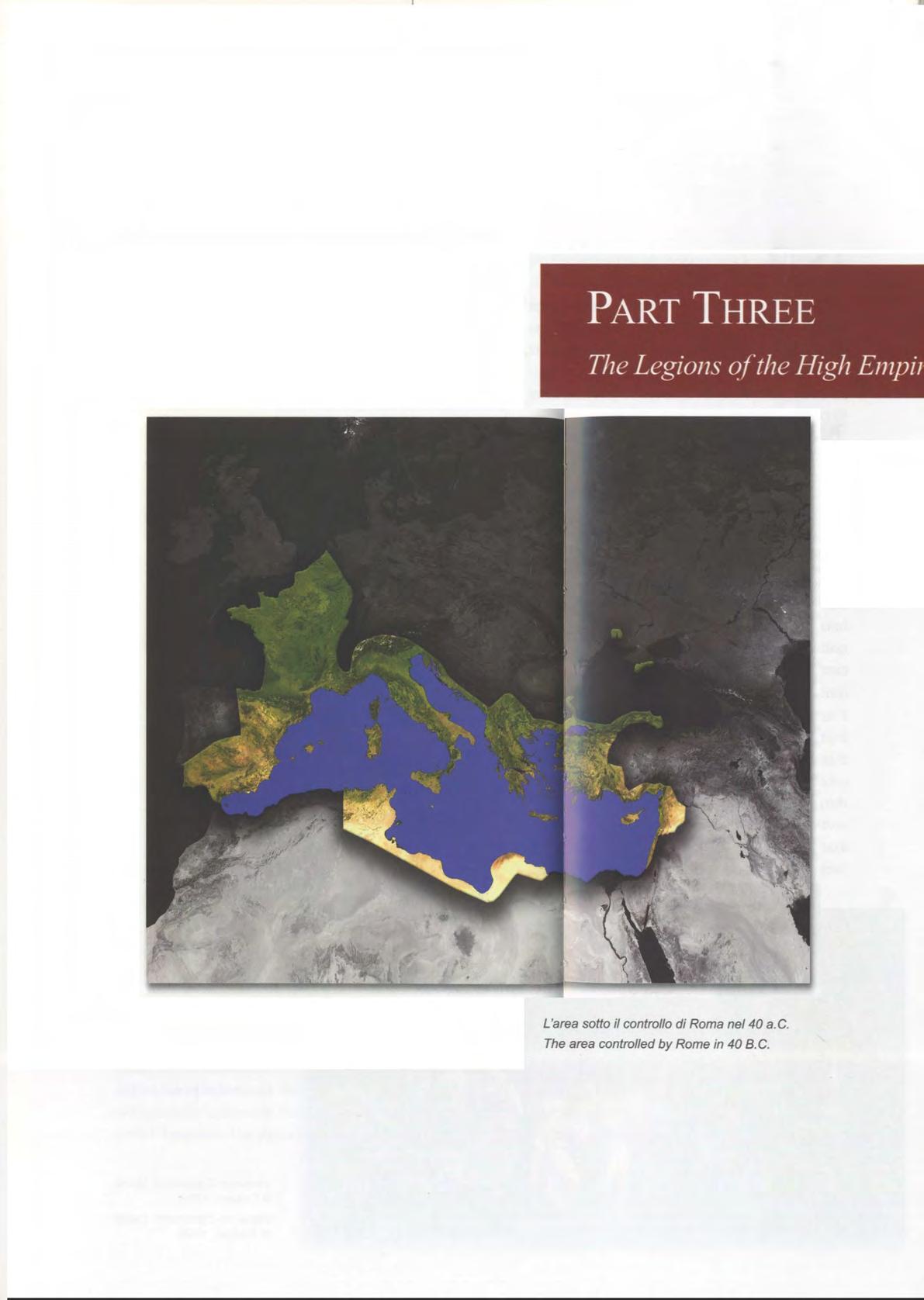
66 minute read
THE RoMAN NAVY INDEPENDENT OF FOREIGN TECHNOLOGY
In 260 B.C. when problems with Carthage become more complex, the command of the fleet passed to Consul Gaius Duilius. The consul:"seeing that his slow ships were easily dodged by the agility of the Carthaginian ships and that this rendered the valour of the soldiers null, invented the «war instrument called corvus»."37 Once again Roman pragmatism was fully manifested in developing the legendary corvus (raven) for boarding: this instrument was destined to transform a battle between ships into a battle between men. Thanks to this device, as all historians pointed out, the legionnaires could board enemy ships and engage the crew in combat similar to land combat. Certainly when first introduced it must have been very effective but it is equally certain that once the enemy ships learned its function they were careful not to approach, nullifying its effectiveness. This explains why there is no mention of it in future battles! These are the characteristics of the device:"a pole 7.1 meters in height and 22 cm in diameter was erected at the bow. This pole had a pulley at the top and at the bottom a ramp made ofcross planks, attached by nails, 1.20 meters in width and 10. 7 meters in length. In this ramp was an oblong slot and it went around the pole at a distance of3. 6 m from its near end. The gangway also had a railing on each of its long sides as high as a mans knee extending along both sides for its entire length. At its extremity was fastened an iron object like a spike with a ring at the other end, and resembled those machines used to grind wheat. To this ring was attached a rope with which, when the ship charged an enemy, the sailors raised the ravens by means of the pulley on the pole at the end ofthe antenna and let them down on the enemy s deck, sometimes from the prow and sometimes bringing them round when the ships collided broadside. Once the ravens were fixed in the planks of the enemy s decks, grappling the ships together, ifthey were broadside on, they boardedfrom all directions but ifthey charged with the prow, they attacked by passing over the ramp two abreast: the leading pair protected the front by holding up their shields, and those who followed secured the two flanks by resting the rims of their shields on the top of the railing. "38
As in the past, this fleet also, so tenaciously built and armed, was deactivated once it had achieved victory over Carthage, as naval policy was not yet part of the Roman strategy.
Advertisement
The Wages Of The Legionnaires
As the legionnaires' periods of engagement continued to increase, it became necessary to compensate them in some manner. Many of the conscripts had a family to support and many others fields they could no longer personally cultivate. Thus, at least initially, more than wages in the true sense of the word, it was a reimbursement of expenses, and partial at that. To give an example, during the time of Polybius, an infantryman received an average of 5 asses per day versus 12 for a labourer in Rome. The stipend thus amounted to 150 asses a month, equal to approximately 10 dinars, which made the annual pay 120 dinars. As we have no modern equivalency for this amount, we can only note that the "as" was a coin of fused bronze, introduced during the IV century, and only later put into circulation. With the reforms of Augustus it was forged in pure copper, and its value became equal to of a cestertius. In any event the entire annual stipend was not sufficient to buy even one inexpensive slave.
This notwithstanding, the military career was beginning to become more attractive, especially since the insignificant wages were supplemented by the frequent spoils. The distribution of booty among legionnaires was common, as were the frequent rewards in money for the most valorous. It was also the custom to increase wages after a victory: but the real attraction was the compensation provided upon conclusion of military service, which was a piece of land plus the sums withheld monthly from their pay. Obviously the higher the rank the higher the wage and this was an additional incentive.
CONSUL GAIUS MAR.rus
Many are familiar with the Cistercian abbey of Casamari, founded by the Benedictines; others may also know of the district of the same name in the munjcipality ofVeroli located in the centre of a small, fertile valley at a height of approximately 300 m, on the road between Sora and Frosinone. Very few however know that the name takes its origin from the Latin Casa Marii, or house of Marius, a name attributed to the site as the birthplace of the illustrious Roman commander, Gaius Marius. Son of a humble farmer, he was born around 155 B.C., and began his military career as soon as he was of an age to be conscripted. The remains of the ancient pagus of the era are allegedly directly underneath the abbey built in the beginning of the XI century. Although he was admired for his unquestionable leaderships skills and for his great personal merit in the Spanish wars and even though he earned a great number of meritorious decorations, he could not justifiably hope in a consequent and adequate social advancement because of his meagre patrimony and plebeian origins. The first deficiency was resolved by reckless and fortunate speculations; the second by marriage to a young member of the Julian family. Thus he became ftrst praetor and later governor of Spain and, in 107 B. C., was appointed Consul, a charge that was conftrmed for four consecutive years between 104 and in 101, an event without precedent in the history of the Republic.
He is remembered for his basic honesty and loyalty to the institutions, his courage and tenacity, but certainly not as a true military genius. Similar to his legionnaires in temperament, taste and culture, he loathed ease, excess and the Greek language, which he did not bother to study, contrary to his wealthy colleagues: a Roman of another era! With such rude merits, the hostility of aristocratic society was a foregone conclusion! His brilliant military victories over the Teutons and the Cimbrians brought him back to Rome in l 01 to celebrate his triumphs and be acquired immense prestige. Which allowed him to effect a permanent reform of the army.
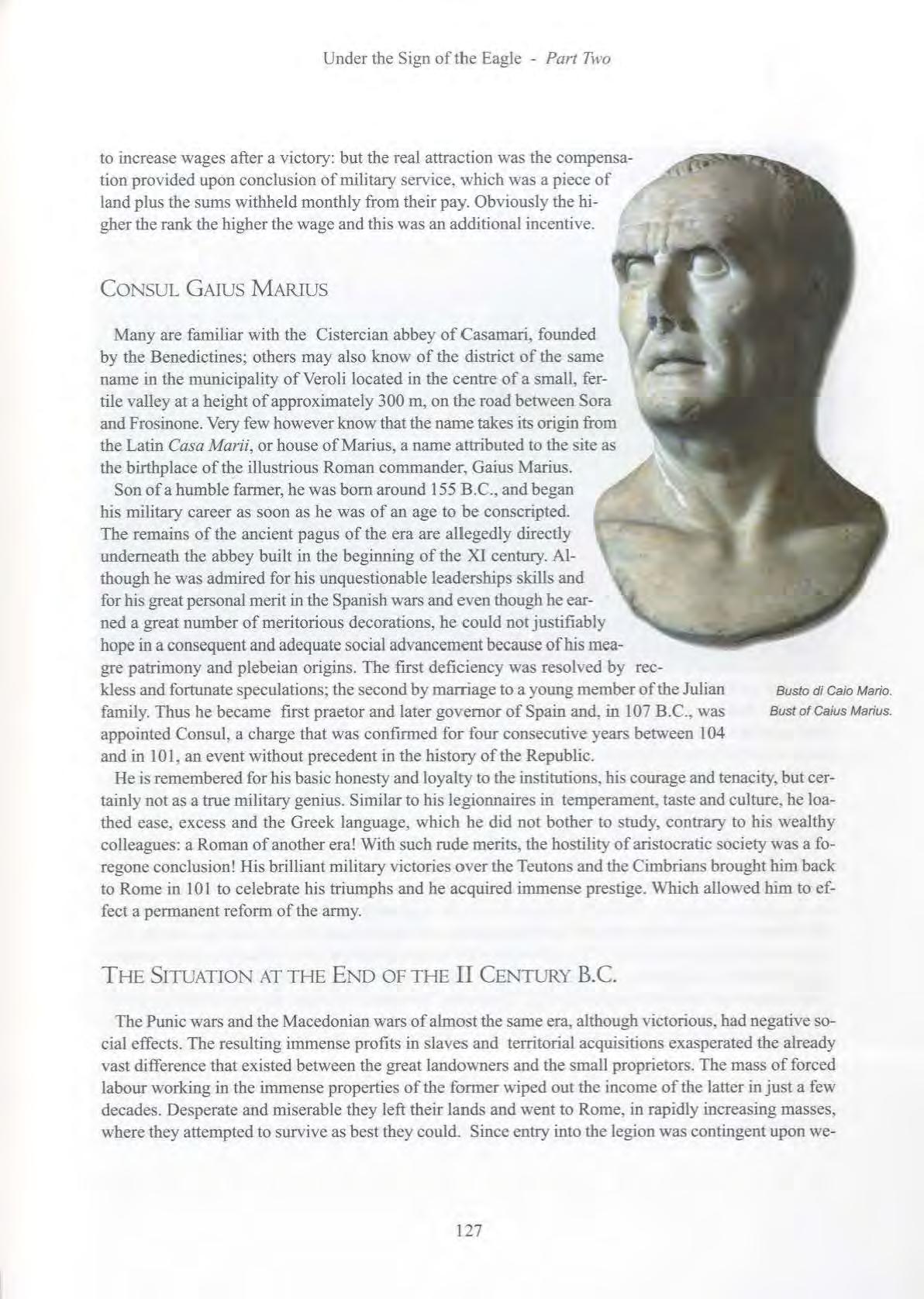
THE SITUATION AT THE END OF THE II CENTURY B. C.
The Punic wars and the Macedonian wars of almost the same era, although victorious, had negative social effects. The resulting immense profits in slaves and territorial acquisitions exasperated the already vast difference that existed between the great landowners and the small proprietors. The mass of forced labour working in the immense properties of the former wiped out the income of the latter in just a few decades. Desperate and miserable they left their lands and went to Rome, in rapidly increasing masses, where they attempted to survive as best they could. Since entry into the legion was contingent upon we- alth, that general and progressive impoverishment corresponded to a just as obvious contraction in the number that could be enrolled. This phenomenon soon reached dangerous levels as the number of men in the military diminished, leading to a decrease in the level of wealth required for enrolment.
With the failure of the proposal submitted by many, but opposed by the Senate, to grant citizenship to the allies, and with the defeat of the agrarian reforms proposed by the Gracchi brothers, the situation precipitated. The:"adsidui began progressively to decrease, both due to a natural demographic regression and because members of the wealthy middle class began to slide toward the proletarii. Inversely, the number of the latter - those citizens who, since they were not members of any of the five classes of wealth, were not constitutionally entitled to bear arms increased to such an extent that they could no longer be ignored for purposes of conscription.
For the second Punic War, in order to enrol a greater number ofthe proletarii they had decreased the minimum level of wealth of the fifth class required for enrolment from 11,000 to 4,000 asses. and this amount was still valid in the era of Polybius, toward the middle of the 11 century. B. C. The increasingly deteriorating situation during this period- from the year 159 the numbers of the census begin decidedly to decrease - obligated them once again, around 133-125 B. C., to lower the minimum requirements of wealth for the fifth class from 4,000 to 1,500 asses: 76,000 proletarii were transfomzed into adsidui, as confimzed by the census of 125 compared with that of 131, but this could not change reality, which gravity did not escape the now concerned ruling class.
During those same years the Gracchi brothers attempted to rectify the economic-social situation the condition ofthe soldiers in that era is revealed by the well known affirmation of Tiberius Gracchus, to the effect that those who were considered the masters of the world did not even have the hovel possessed by animals, and by the military law ofGaius Gracchus (123 B. C.) prohibiting the State from making withholdings from the stipendium, given the precarious condition of the soldiers.

Thus in 107 B. C., when Gaius Marius was forced to abandon the traditional system ofconscription by tribes because of the war in Numidia and recur to voluntary enrolment, the composition ofthe army was already, de facto, proletariat. The measures implemented by Marius, similar to the institution of the tumu/hiS and that already had precedents in the conscription of 134 B. C., did not appear to be revolutionary and in reality did no more than conjim1 the preceding de facto stahiS. ·'3'
This modification, only apparently technical , had considerable political consequences as henceforth the legionnaires were no longer greatly involved in the political matters of Rome but exclusively in their career, their recompense and their general. Loyalty was increasingly associated with those who enrolled them rather than with the Republic, an entity viewed as progressively more remote and foreign. A further consequence was the amalgamation of the numerous Italic ethnicities into a single military class, the first national unification of the Roman state, that from a merely technical aspect was still the city of Rome! Thus there emerged a paradoxical duplicity, on the one hand the survival of an archaic urban political dimension and on the other the advent of an Imperial military dimension, antithetical contexts that the Marian reforms began to resolve. From another perspective "the popular faction benefited from the fusion that had now taken place within the army among different elements of the various Italic regions, as it could now defend common economic and social needs that, as stated, the army personified [In general therefore] in the I c. B. C. popular leaders and military leaders are identified with the organisation of the masses against oligarchy- or with their use if. like the army, they were already organisedgiving rise to an accommodation between the needs of the Imperial state and the structure ofthe ancient citizen State, something that the military had already achieved in its own field when urgent need had transformed it into a professional army, around the If c. B. C. " 40

The Marian reforms also led to other consequences intrinsic to the military career. According to ancient and confirmed tradition there was a clear and insurmountable separation in the Roman army between legionnaires up to the rank of centurion, who today would be called junior officers, and the superior hierarchy or senior officers. No centurion, for example, could ever hope to attain the rank of tribunum militum or praefectus equitum, whatever his merit or wealth. With the Marian reforms, opening the way to a professional army, this preclusion was no longer absolute and incontrovertible. A not irrelevant number of cases confirms promotions from the lower ranks to higher ranks, especially when supported by conspicuous wealth that even opened the door to the equestrian rank.
THE LEGION OF GAIUS MARlus
If the Marian reforms bad extraordinary political effects they had even stronger tactical ones. His legion, recently emerging from the war in Spain, was clearly different from the preceding maniple organization and more suited to the new tasks and new methods of combat. The maniple legion that bad defeated the Macedonian phalanx did not conftrm its superiority when it had to confront the Cimbrians and the Teutons. Its quincunx arrangement of staggered maniples, was not able to repel the initial powerful attack with its typical tactic of opening the battle with a violent assault against the centre of the enemy formation. And the wide spaces between the maniples allowed the attackers to rush forward and penetrate the soldiers of the front line until they reached the second. At that point resistance began to diminish, as all the individual maniples, especially those of the front line, found themselves isolated and
Hastati Principes Triari
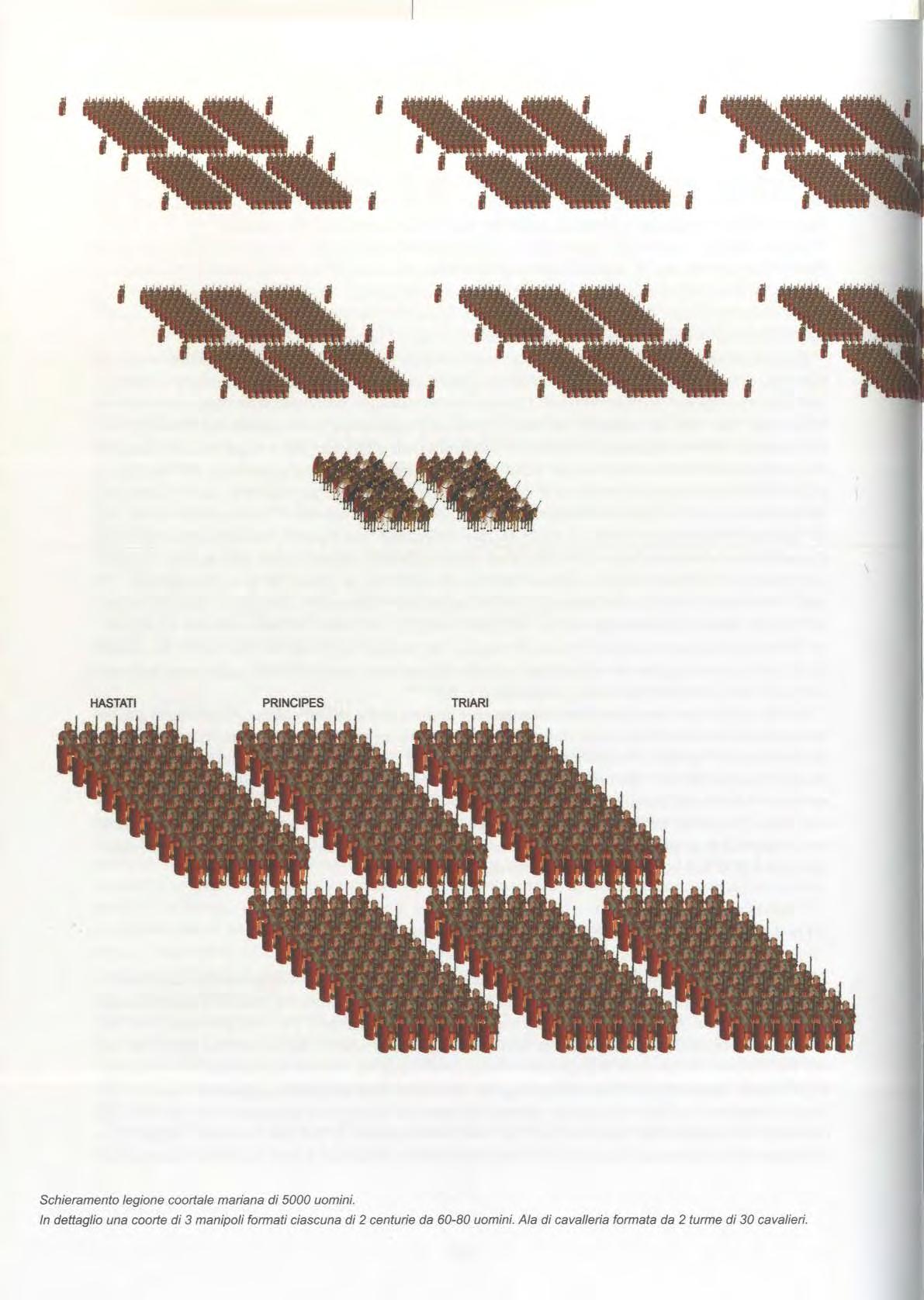
Legion cohort formation of the Marian period, numbering 5 ,000 men A cohort of 3 maniples, each consisting of 2 centuries of 60-80 men Cavalry w i ng consisting of 2 squadrons of 30 horsemen.
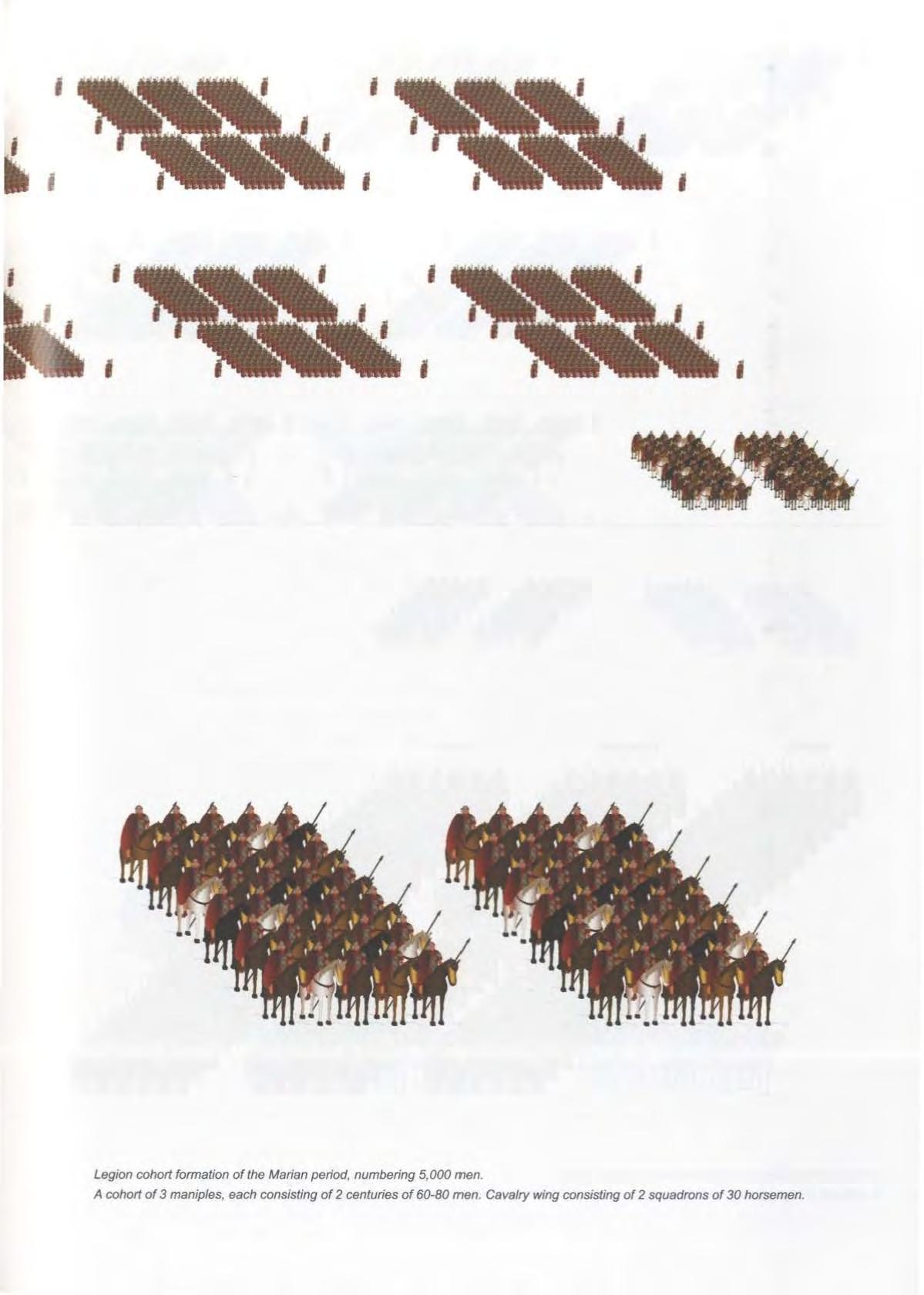
HASTATI PRINCIPES TRIARI
Schieramento legione coortale cesariana di 5000 uomini. In dettaglio una coorte di 3 manipoli formati ciascuna di 2 centurie da 60-80 uomini. Ala di caval/eria formata da 2 turme di 30 cavalieri.
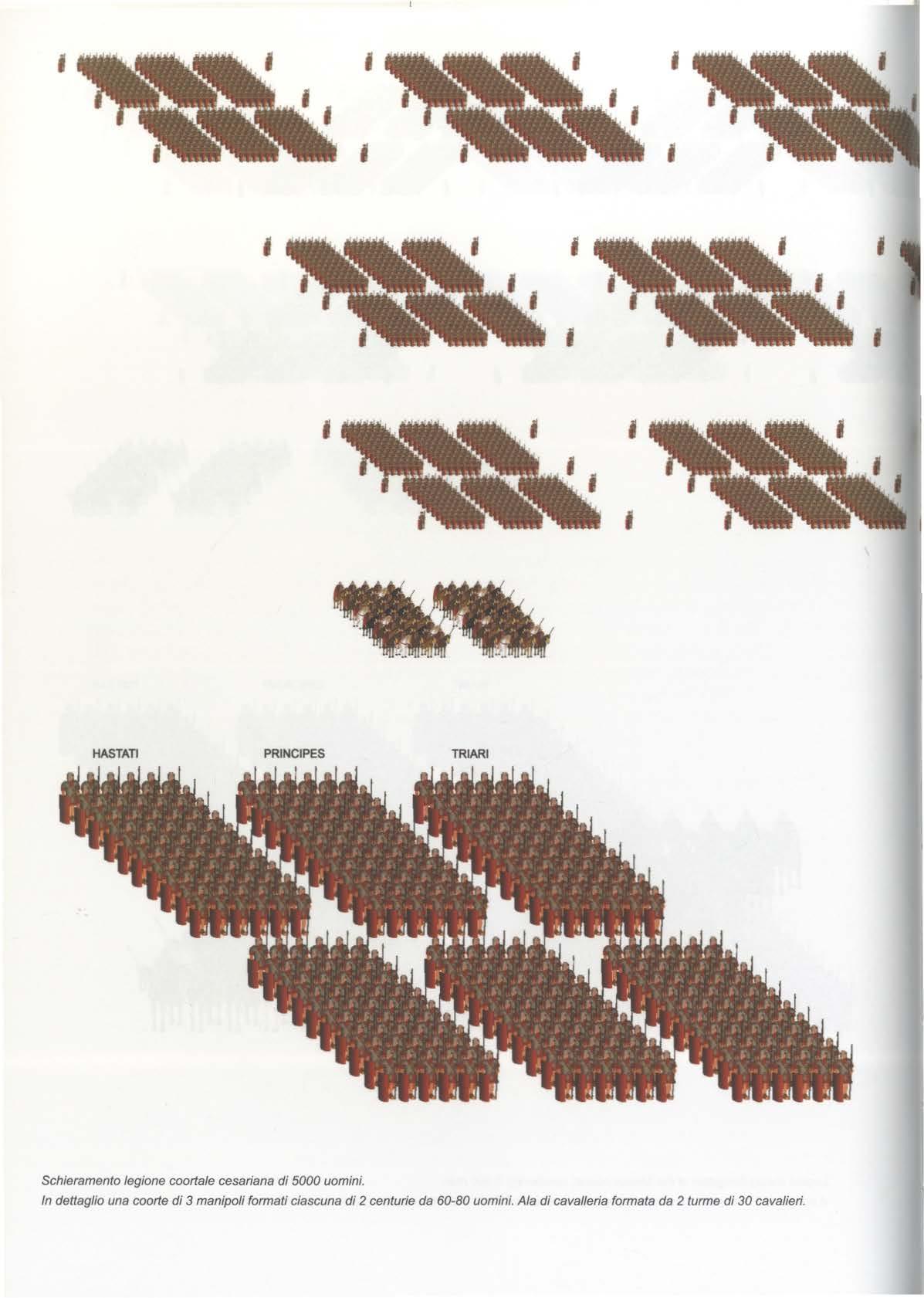
Cavalry cohort detachment of the Caesarian era , 5,000 men surrounded by a human tide. Mutual support became impossible among themselves and among the different lines that did not have the necessary strength to resist alone. The conclusion left no room for doubt: the staggered arrangement of the maniples was too weak to sustain and resist such a tactic. The advantage of rapid manoeuvrability provided by a light maniple in the Apennine theatre backfired in the Nordic one. Not even the ancient phalanx would have provided better results as it could not have sustained a central attack of such impetus and violence without breaking!
A cohort of 3 maniples, each consisting of 2 centuries of 60-80 men Cavalry wing consisting of 2 squadrons of 30 horsemen.
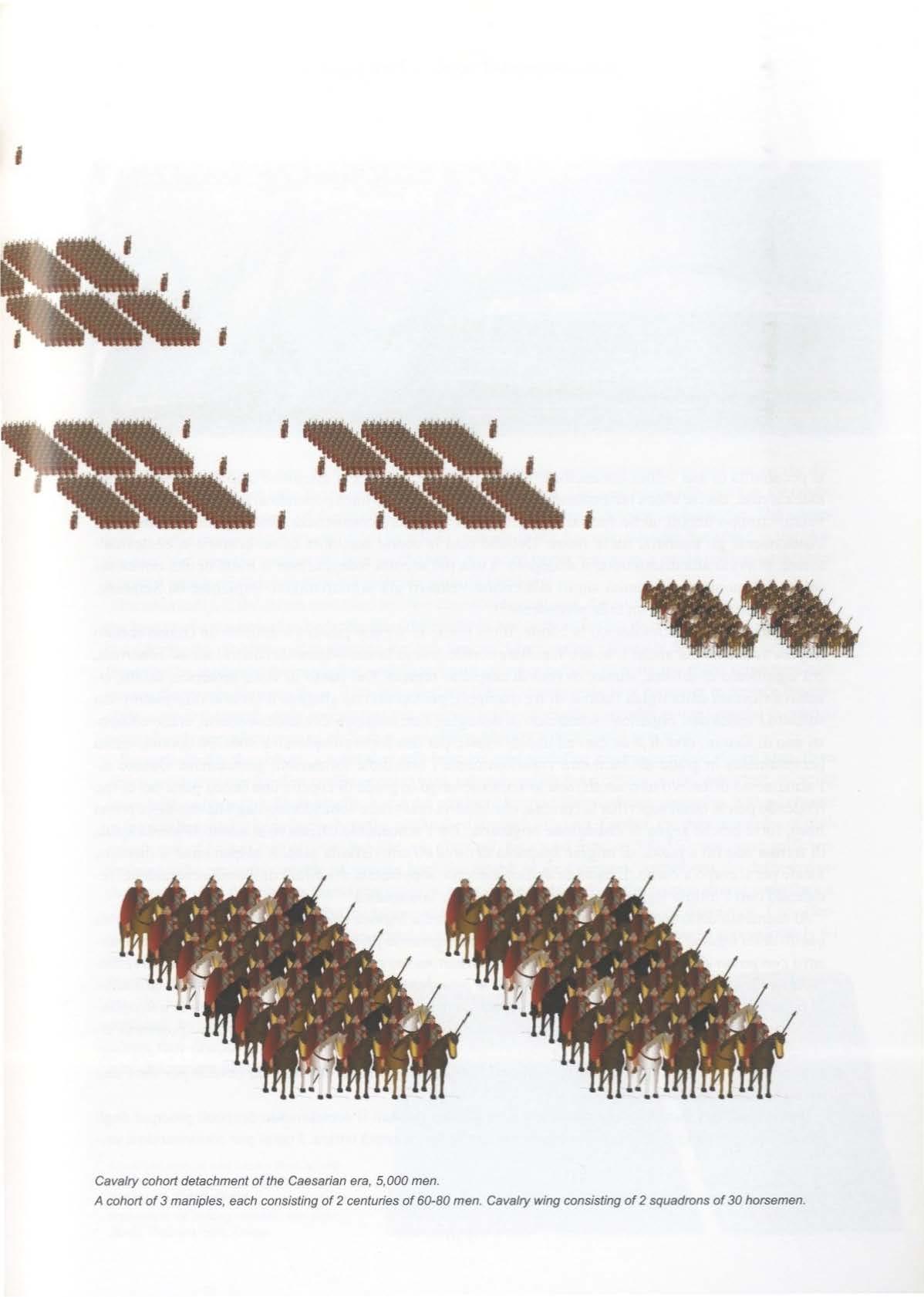
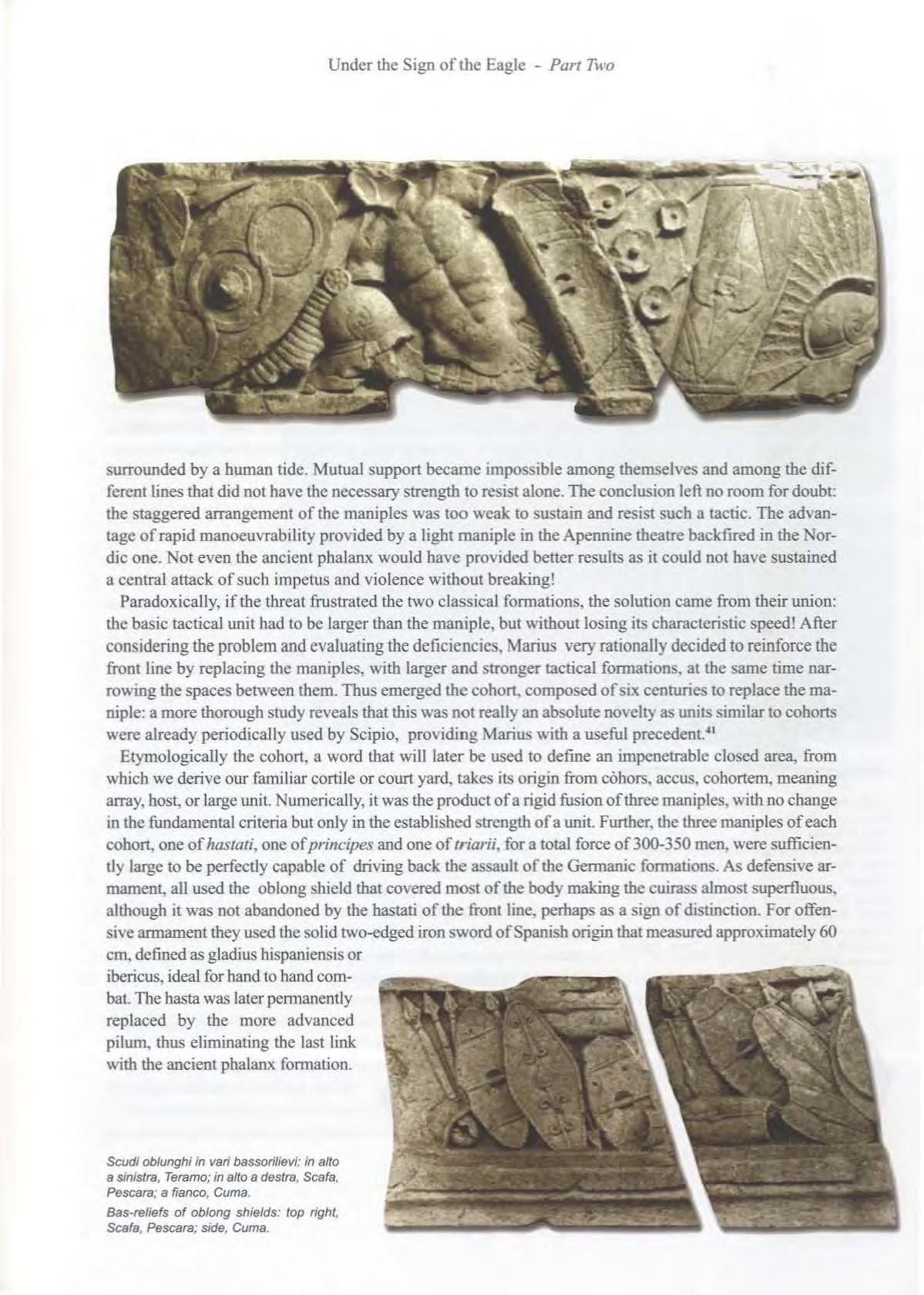
Paradoxically, if the threat frustrated the two classical formations, the solution came from their union: the basic tactical unit had to be larger than the maniple, but without losing its characteristic speed! After considering the problem and evaluating the deficiencies, Marius very rationally decided to reinforce the front line by replacing the maniples, with larger and stronger tactical formations, at the same time narrowing the spaces between them. Thus emerged the cohort. composed of six centuries to replace the maniple: a more thorough study reveals that this was not really an absolute novelty as units similar to cohorts were already periodically used by Scipio, providing Marius with a useful precedent. 41
Etymologically the cohort, a word that will later be used to define an impenetrable closed area, from which we derive our familiar cortile or court yard, takes its origin from cohors, accus, cohortem, meaning array, host, or large unit. Numerically, it was the product of a rigid fusion of three maniples, with no change in the fundamental criteria but only in the established strength of a unit Further, the three maniples of each cohort, one of hastati, one of principes and one of triarii, for a total force of300-350 men, were sufficiently large to be perfectly capable of driving back the assault of the Germanic formations. As defensive armament, all used the oblong shield that covered most of the body making the cuirass almost superfluous, although it was not abandoned by the hastati of the front line, perhaps as a sign of distinction. For offensive armament they used the solid two-edged iron sword ofSpanish origin that measured approximately 60 cm, defined as glad ius hispaniensis or ibericus, ideal for hand to hand combat. The hasta was later permanently rep laced by the more advanced pilurn, thus eliminating the last link with the ancient phalanx formation.
At the moment of confrontation :"the battle scheme of the cohort legion was not much different from the maniple legion, in the first and second line were engaged: the first advanced at the double, spreading out and ready for combat with the sword, immediately following the launching of pili; la second line followed hard on as soon as the first line had completed its initial onslaught; the third was the reserve force that the commander used if and when he considered it opportune or necessary. The auxiliary wings remai- ned subordinate and never had decisive roles, but they could distinguish themselves by valorous acts ... The cavalry provided flank support and were usedfor reconnaissance, pursuit, rapid transport and often, dismounted, to assist in close engagements". 42
The passage from maniple to cohort also diminished the basic roles of the hastati, the principes and the triarii, now united into a single tactical unit. The names continued to exist, but from that time on they were used more to identify the respective centurions. with the definition pi/ani replacing that of triarii. The logic of the change is simple: as the pi/ani were the most expert and reliable legionnaires their name was given to the highest ranking centurions, while principes were the intermediate level and hastati the lower ranks. Thus:"in each cohort, from the /I to the X the ranks of the centurions, by order of importance, were now pilus prior, princeps prior, hastatus prior, pilus posterior, princeps posterior, hastatus posterior. The titles of the centurions of the first cohort, now called primi Ol'dines, were slightly different: primis pilus, princeps, hastatus, princeps posterior, hastatus posterior. It is not clear ifat that time the first cohort had five centurions as during the Imperial Era, or six (two primi pili). The decrease to five was probably due to the fact that the prim is pilus bis (that is for the second time) was more useful as a general staff officer."43
This same reform was also responsible for the suppression of the \.·elites and the abolition of the legionnaire cavalry, both the result of the elimination of the related categories of wealth. They were replaced by special units of auxiliaries and allies: the equites that remained in each legion, perhaps numbering 120, were used for various tasks, but not tactical ones. Marius initiated yet another innovation, destined to play a very important role in the future and partially foreseeable in the strong interdependence between a legion and the commander who had enrolled it: the granting of a specific identity. From this moment on each legion had its own "aquila" or 'eagle', an emblem that arose to the level of divine dignity, venerated in a special shrine as a numen legionis. For purposes of completeness we must also note the measures taken by Marius to accelerate the march of the legions, until then hampered by the great number of supply wagons that accompanied them. Not incidentally those slow convoys were defmed as impedimenta, but as they were essential to feed the entire army, no commander had ever considered the possibility of decreasing their number. Not so Marius, who eliminated a great many of the wagons by loading supplies on the backs of the legionnaires, who then became known as the muli mariani (Marian mules).

Everything that an individual legionnaire had to carry, in addition to his military equipment, was supported by a special forked staff, called furca or sarcina, a term still used in many dialects of southern Italy. The contents of this backpack can be deduced from reports of the era such as that of Cicero 44 who wrote that the legionnaire, in addition to his own weapons, transported food rations for five days and whatever else he needed in the field, such as utensils like the mattock or the axe. The overall weight was estimated at around 26 kg, but more recent studies indicate that this may have even exceeded 40 kg! Some writers even reach approximately 55 kg: it is interesting to note that the French zuave during the second empire also carried backpacks containing 35 kg.

These weights varied according to circumstance and also according to the legionnaires. Not all were forced to carry the same equipment or the same objects, many of which were sufficient for an entire squadron. For example, it would be absurd for each legionnaire to carry his own dishes. his own grinder for wheat and to cook his own food individually rather than together with the eight colleagues with whom he shared the same tent! Nor could Marius' simp l ification eliminate all the carts as these were also needed for the war machines, field equipment, instruments, water reserves and fodder for the animals. According to some scholars, with such weights the legionnaire could cover a daily distance from 20 to 30 miles (48 km).
This calculation, though questionable, generally refers to distances on roads. that is, those that could be effected only after the roads had been built, something that came about once the conquest had been stabilised, and only to approach the base of departure for the campaigns. When campaigns were conducted in enemy territory they could not benefit from such infrastructures, making the travel and advance times much slower than those on a regular road.
THE LEGIONNAIRE'S LIGHT ARTILLERY
Shortly before the destruction of Carthage, in the days of its glorious and over-ambitious resistance to the Roman forces that were laying siege to its cities, all its citizens dedicated themselves to building launch machines and weapons. Every historical report tells of the sacrifice of the women who donated their hair to provide the catapults and ballistas with the necessary elastic coils for propulsion. 46 And when the city finally fell, the Romans captured a great number of such artillery, of various power and dimension. These were not unknown weapons nor anns of futuristic conception as the legions already had similar ones, if not better. thanks to the Greek technicians \\ho served under them. We are not familiar however, apart from some remains fortunately found in Spain 47 , with the specific equipment carried by the legions during the Republican era, nor which type used for field attacks and which for defence.
Putting aside the theoretical and concentrating on actual facts, it is interesting to reconstruct the pair of scorpions found in Spain, the almost intact one found in Mainz and the most damaged one discovered in Cremona. Specifically, these are propulsion devices that, in spite of their chronological diversity, appear to be absolutely identical and so wholly compatible that the loading flanges of the oldest could rotate in the housings of the most recent, despite the almost three centuries that separate them, with an overall tolerance of only a few millimetres 48 - proof of the high level of standardisation of these military devices. Furthermore, since all are perfectly compliant with the construction dictates ofBiton, Philon and Vitruvius, they can be used as dimensional modules to complete the missing parts and restore the original characteristics of these weapons. Such an activity, once completed, permits an assessment of their actual ballistic function.
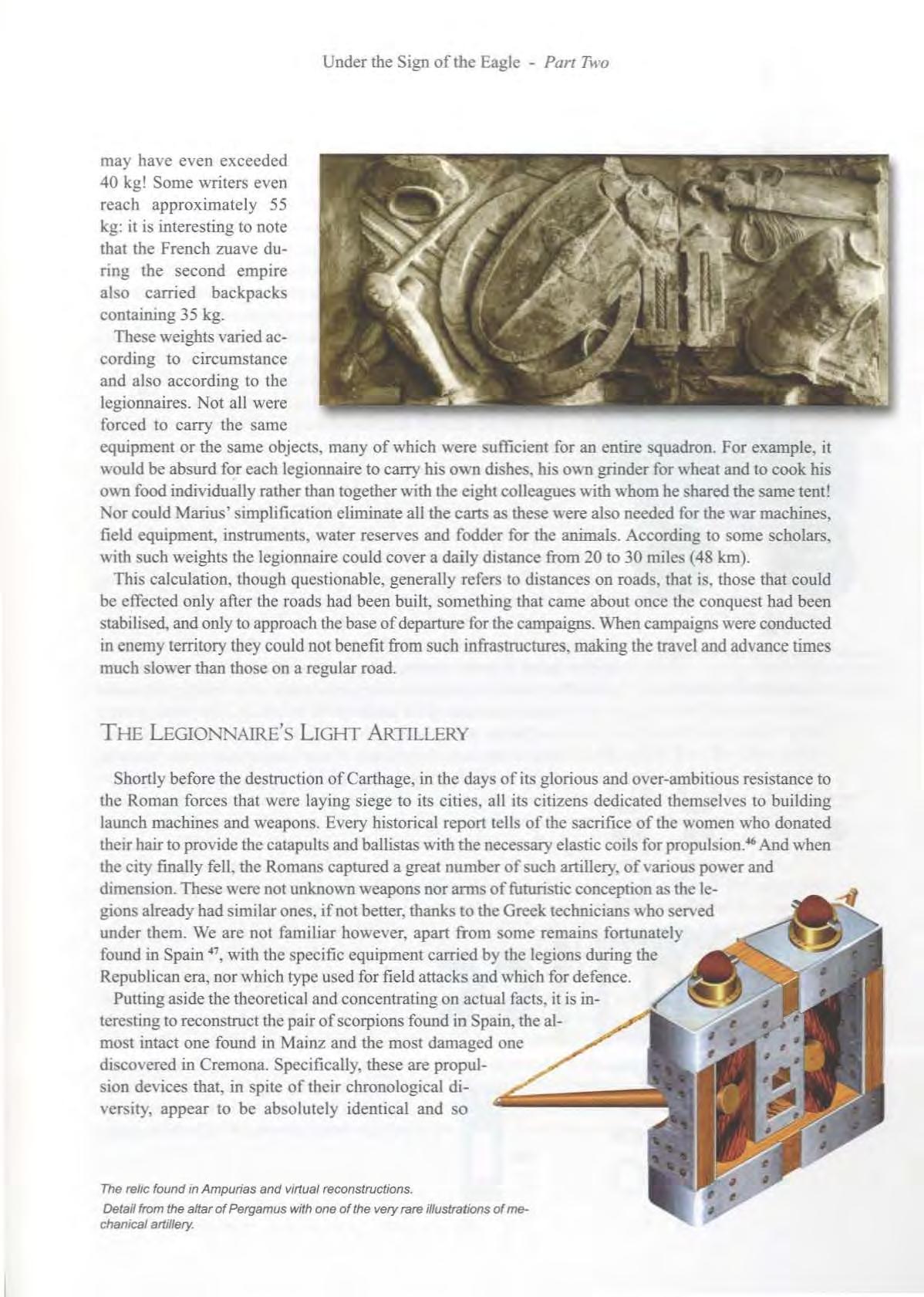
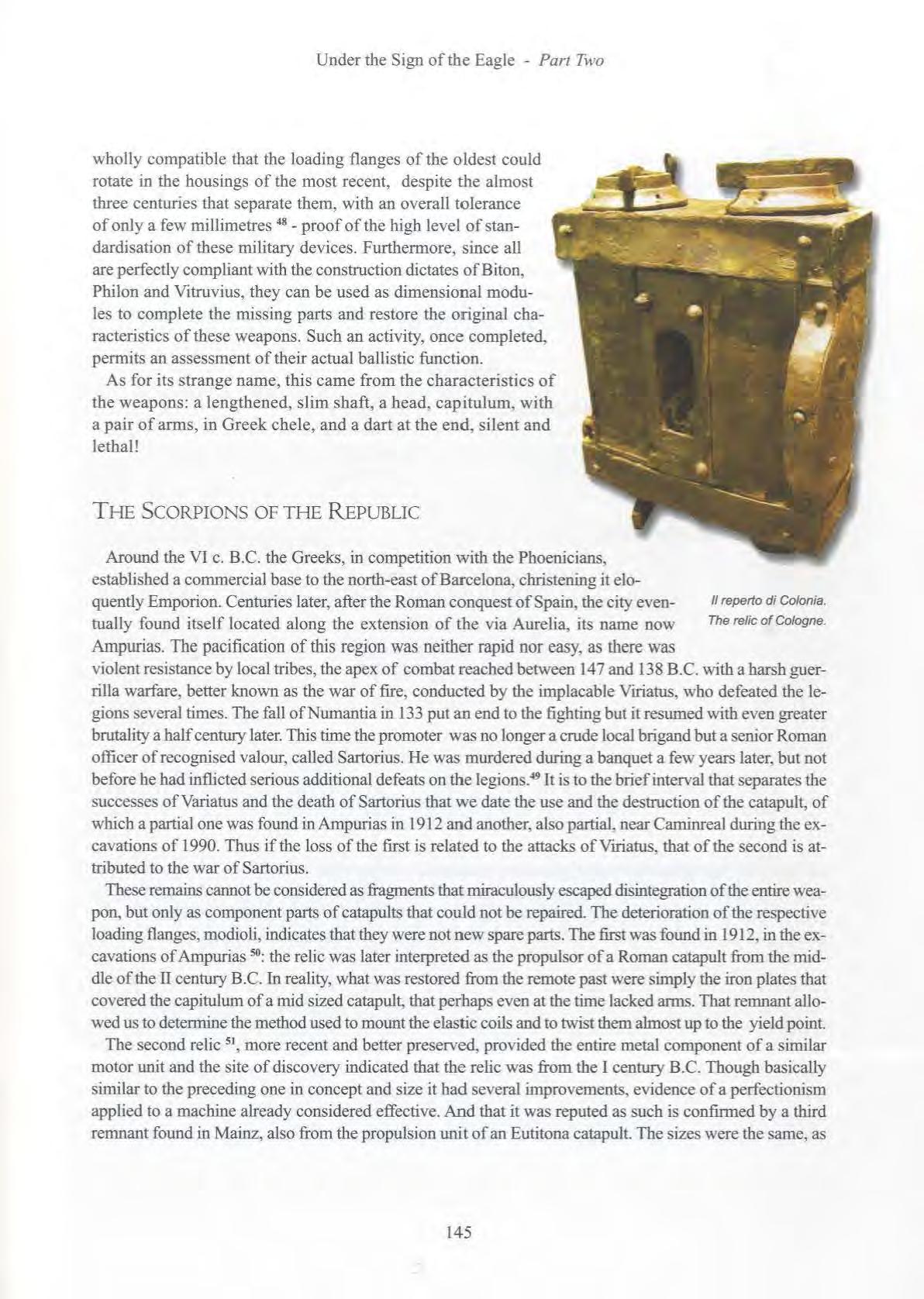
As for its strange name, this came from the characteristics of the weapons: a lengthened, slim shaft, a head, capitulum, with a pair of arms, in Greek chele, and a dart at the end, silent and lethal!
The Scorpions Of The Republic
Around the Vl c. B.C. the Greeks, in competition with the Phoenicians, established a commercial base to the north-east of Barcelona, christening it eloquently Emporion. Centuries later, after the Roman conquest of Spain, the city even-
11 repetto di Colonia. tually found itself located along the extension of the via Aurelia, its name now The relic of Cologne. Ampurias. The pacification of this region was neither rapid nor easy, as there was violent resistance by local tribes, the apex of combat reached between 147 and 138 B.C. with a harsh guerrilla warfare, better known as the war of fire, conducted by the implacable Vuiatus, who defeated the legions several times. The fall ofNumantia in 133 put an end to the fighting but it resumed with even greater brutality a half century later. This time the promoter was no longer a crude local brigand but a senior Roman officer of recognised valour, called Sartorius. He was murdered during a banquet a few years later, but not before he had inflicted serious additional defeats on the legions. 49 It is to the brief interval that separates the successes of Variatus and the death of Sartorius that we date the use and the destruction of the catapult, of which a partial one was found in Ampurias in 1912 and another, also partial, near Caminreal during the excavations of 1990. Thus if the loss of the first is related to the attacks ofVrriatus, that of the second is attributed to the war of Sartorius
These remains cannot be considered as fragments that miraculously escaped disintegration of the entire weapon, but only as component parts of catapults that could not be repaired. The deterioration of the respective loading flanges, modioli, indicates that they were not new spare parts. The first was found in 1912, in the excavations of Ampurias 50 : the relic was later interpreted as the propulsor of a Roman catapult from the middle of the II century B.C. In reality, what was restored from the remote past were simply the iron plates that covered the capitulum of a mid sized catapult, that perhaps even at the time lacked arms. That remnant allowed us to determine the method used to mount the elastic coils and to twist them almost up to the yield point.
The second relic 51 , more recent and better preserved, provided tbe entire metal component of a similar motor unit and the site of discovery indicated that the relic was from the I century B. C. Though basically similar to the preceding one in concept and size it bad several improvements, evidence of a perfectionism appJjed to a machine already considered effective. And that it was reputed as such is confirmed by a third remnant found in Mainz, also from the propulsion unit of an Eutitona catapult. The sizes were the same, as were the general features and details: with one remarkable difference, the use of bronze for the plating rather than iron and the three frontal plates to better protect the coils. A better constructed weapon, perhaps because it was to be used in more rigid climates, dating approximately to the I century A.D. Just slightly older were the remains of a fourth propulsion unit from a catapult of analogous power, found in Cremona in 1887, but only correctly interpreted a century later. In this case the remnant consisted of eight modioli of identical form and size, and a frontal plate acting as a single shield for both coils. As this weapon also was from the I century A.D. the use of a single armour confirms the tendency to greater protection for such artillery, already noted in the Mainz propulsor. The plate bears the foUo'"'ing inscription 52 :
LEG IIli
MVINICIO II CVIBIORVF CHORAT ...
The correct Latin version being:
MAC
TAVRO O CORVI 1\0 ... S INOLEC . .. RINC ...
LEGIO QUARTA MACEDONlCA
MARCO VINICIO ITERUM, TAURO STATILO CORVINO (COS) CONSULIDUS
CAIO VIBIO RUFINO LEGATO CAIO HORATIO PRINClPE which translated means:
PROPERTY OF THE fOURTH
LEGIO!\
UNDER THE SECOND CONSULSHIP OF MARCUS VINICfUS, AND OF STATILIUS TAURUS CORVINO, U'.1>ER THE COMMAND OF GAIUS VIBIUS LEGATE (PROPRA.ETOR OF LPPER GER\iA'"Y), GAIUS 0RAZ10 BEING THE PRINCEPS OF THE PRAETORJlJM

A catapult of the IV Macedonian Legion, built during the Imperial Era, another perhaps from the Legio XXX whose stronghold was located in Xanten, along the Rhine, also of the same era, basically similar to the two Republican ones! Explicit confmnation of the excellent level of Roman light artillery as early as the II century B.C., and that will be radically transformed and reinforced with a new propulsion unit only after the Il century A.D.
As for Roman heavy and siege artillery all indicates that this was basically similar from a formal and mechanical aspect but, obviously, larger. Such weapons were rather like magnified light artillery, according to Vitruvius. There is, however, one area of doubt regarding a strongly parabolic firing weapon, almost a prototype of the mortar, referred to as early as the II century B.C. in Greek technical treatises. The language should not deceive us as Greek was the language of the more advanced technicians, even those of Roman origin or at the service of the Roman army. Thus we can easily conclude that what was written by Philon on the so called monoancon, or single arm, weapon was widely known and used even by the legions: this was a large weapon with a single coil and arm. Its frame was very similar to the tension saw, with an arm in lieu of the listel. At one end was an automatic-opening sling, commanded by a centrifugal force containing a projectile, almost always a heavy stone. Its curved firing during a siege made it possible to strike the structures behind the walls, creating a very powerful effect. This machine will receive many upgrades in the following centuries and will eventually become the medieval catapult and trabuch. 53

If there were ever any doubt regarding the existence of an onager as early as the I c. B.C., there is a rather singular proof in Pompeii. Along the northern section of its walls are hundreds of prints left by the ballistas of the siege artillery of Silla in 89 B.C. The larger ones have a diameter that varies from 120 mm to 160 mm with penetrations of approximately 120-140 mm along the extrados of the walls. Inside the city, furthermore, were found hundreds of stone balls, probably hurled during this siege. These are much larger than the former and exceed the maximum calibres of those used by the ballistas: the only explanation is that a weapon with a strongly parabolic firing device hurled them inside the walls.
Una catasta di proietti di artiglieria elastica rinvenuti a Pompei.
Un 'altra impronta balistica.
R1coslruzione virluale de/la bafJSta di VttnMo, utilizzata probab;fmente durante f"assecfio di Si/la
A pile of projectiles used by elasttc artillery. unearthed in Pompeii. Another ballistic impression.
Virtual reconstruction of the ballista of Vitruvius, probably used during the siege of Si/la.
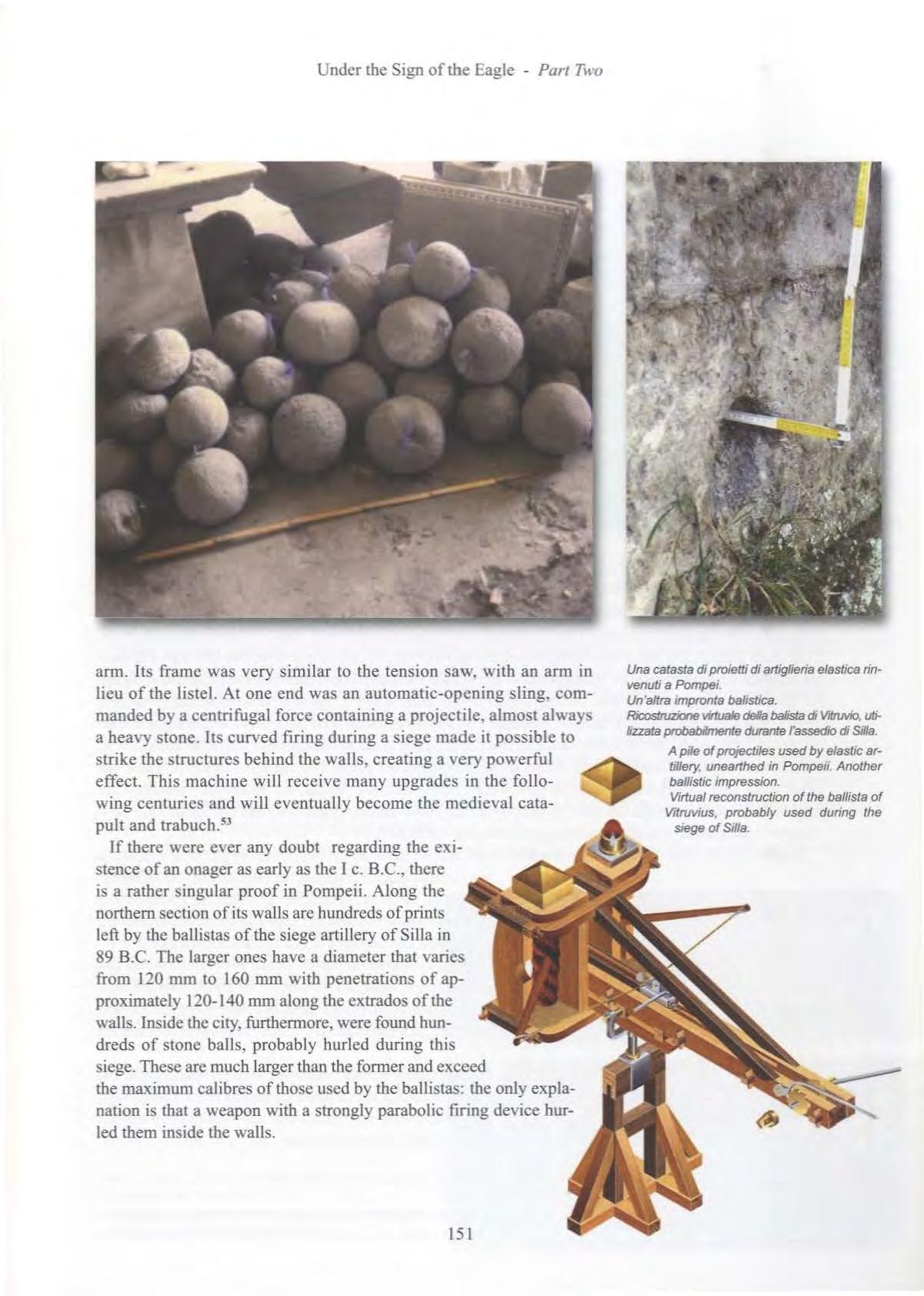
TACTICAL OBSERVATIONS ON RoMAN CAMPs

Whatever its original connotation, the Roman legionnaire camp must be viewed as an actual mobile base, a reality that was constantly present and never neglected or carelessly prepared even in the worst operational contexts. The difference was not in its geometric form or its functional system, but in its overall solidity, as it was commensurate to the presumed duration of the sojourn and the expected use. No matter the work that was required, the legions did not do without their camp, not even for a brief nocturnal pause in the course of a forced march or rapid relocation. It was a hard and fast rule oflegionnaire field operations, under any circumstance, to pass half the day marching toward the enemy and the other half pitching camp. A standardized and moderately fortified structure even in its most elementary configuration and for the most ephemeral of stays, very similar to a temporary fortification or a gigantic cuirass put on at every stop!
Many scholars consider such a laborious and meticulous process to be an excessive waste of time and energy, though the fact that this process remained in force for so many centuries in the most combative and organised army in history certainly provides an indication of its importance. Every evening the legionnaires had to seek shelter inside a fortified rectangle. These were camps set up at the end of every period of march, obviously for temporary use, castra estiua, and that were abandoned the following morning. They differed in the consistency of their defences, in size as some were used for entire seasons, or even for years, and were called permanent camps or castra hiberna, statiua, and in the material used which were often massive walls of stone or brick. These are the structures that have left the greatest archaeological traces still perfectly evident today. 54
To better describe a Roman encampment, which had reached its basic configuration as early as the beginning of the m century B.C. , it should be noted that:"in the Republic and at the beginning of the principate, the most characteristic of the Roman art of war had been the temporary camp. At the end ofa day ofmarching the legionnaire troops were assembled in one site, previously chosen with great care, and here, working for three hours and more, they excavated a defence moat all around, erected a rampart, made a palisade using prefabricated elements (pi/a muralia) and finally pitched their tents. According to the archaeological remnants preserved in certain sites the perimeter of the encampment could have various forms, while the interior layout seems to have ·ed a fixed scheme: the tents were grouped by units around a wide T shaped road, that went through the centre ofthe camp in the direction ofthe area reservedfor the headquarters. Between the interior side ofthe rampart and the first row oftents was a large open space. Modem critics have often observed that the security provided by this type of camp was not commensurate with the enormous effort required to construct it after a day of marching, as the mobility of the Roman army was no doubt significantly reduced by this long and tiring routine. Nevertheless, even though a fragile palisade cornposed oftwo pointed portable poles, the moat only three Roman feet deep, and the rampart only a meter ninety high, could not do much to contain a strong attack, it would be a mistake to underestimate the tactical usefulness ofthe defences typical ofthe temporary camp.
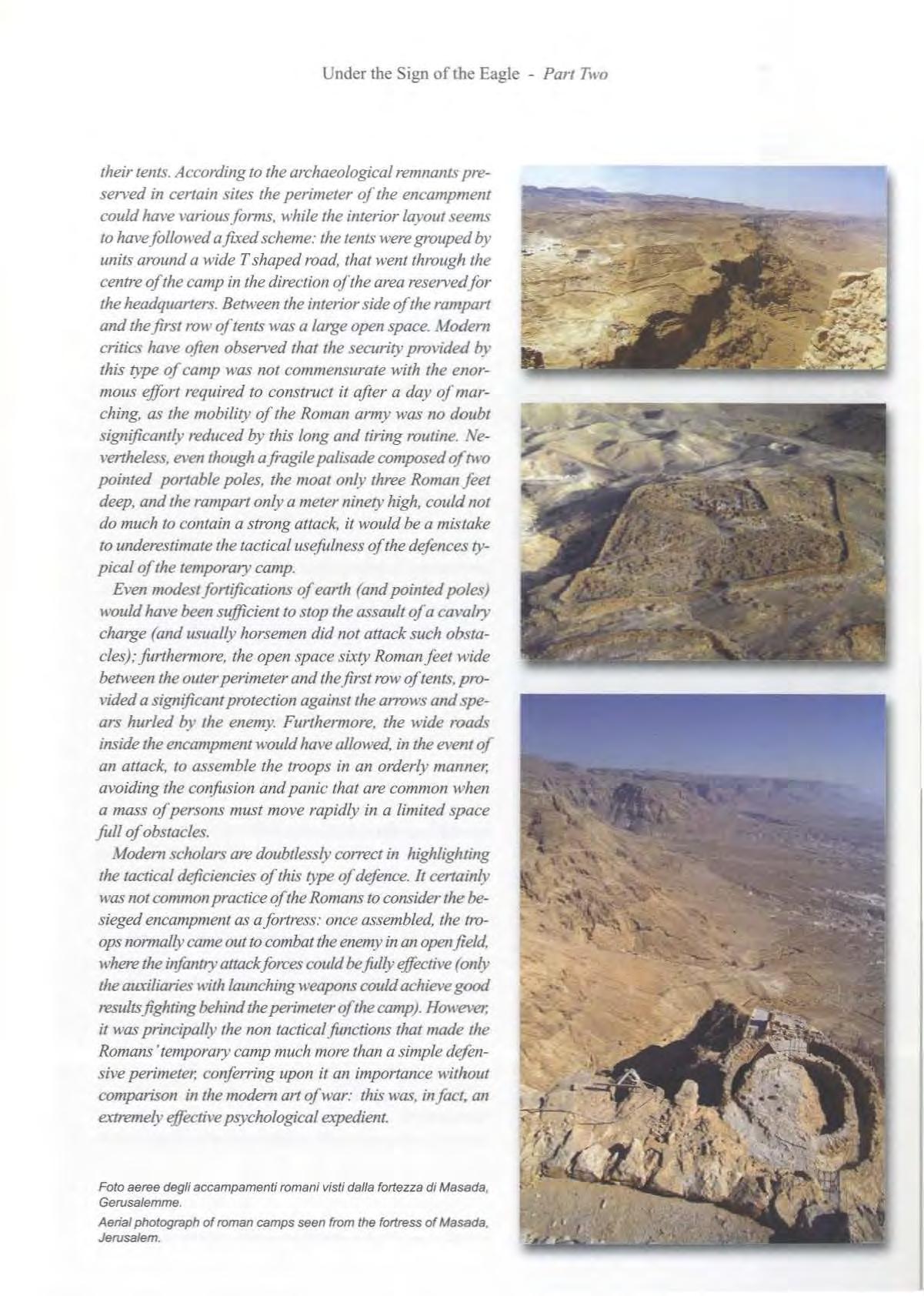
Even modest fortifications of earth (and pointed poles) l ·ould have been sufficient to stop the assault ofa ca1-·alry charge (and usually horsemen did not attack such obstacles); furthem10re, the open space sixty Roman feet wide between the outer perimeter and the first row oftents, provided a significant protection against the arrows and spears hurled by the enemy. Furthermore, the wide roads inside the encampment would have allowed, in the event of an attack, to assemble the troops in an orderly manner, avoiding the confusion and panic that are common when a mass of persons must move rapidly in a limited space full of obstacles.
Modern scholars are doubtlessly correct in highlighting the tactical deficiencies of this l)pe ofdefence. It certainly was not common practice ofthe Romans to consider the besieged encampment as a fortress: once assembled, the troops came out to combat the enemy in an open field, where the infantry attackforces could befully effective (only the auxiliaries with launching weapons could achieve good resultsfighting behind the perimeter ofthe camp). However, it was principally the non tactical functions that made the Romans 'temporary camp much more than a simple defensive perimeter, conferring upon it an importance without comparison in the modern art of war: this was, in fact. an extreme(v effective psychological expedient.
First, a marching amzy in hostile and often unknown territory, would feel secure in the familiar strocture ofan encampment. With the moat, the rampart and the palisade to keep the sporadic natives and ferocious beasts at the soldiers could wash, prepare their equipment, converse and relax in a comfortable atmosphere. This feeling ofsecurity allowed them to sleep serenely and to then be ready to march or battle on the following day. nzus the brotalisation and the fatigue accumulated by the troops engaged in a military campaign could be partially compensated by the restoration of a good night's sleep.
The temporary camp was also an expedient to lessen the amount of work. It is true that much work was required to build it, but thus fortified it could be adequately controlled by a minimum number of sentinels. The l).pical goal of night operations is to prevent the enemy from sleeping; even if inflicting minimal damage, the noise of surprise attacks night after night could provoke a progressive deterioration of the physical and mental conditions of the troops who were the object ofsuch attacks, especially as an increasing number of soldiers would go without sleep to carry out patrol duf): In this case also, the temporary encampment offered the advantage ofpreserving the energy of the soldiers, since, if we can trost our sources, sixteen men out ofa century of were used each time. "55
Temporary Fortification
To get an idea of the fortifications that camps used for even just one night or barely longer, we must turn once again to Flavius Vegetius. Scrupulous researcher that he was, he collected and reported the basic reminiscences of such structures beginning with the technique used for their construction. According to his words, the legionnaires began by superimposing regular courses with:"the sods uprooted ... [forming] a vallzmz upon which they placed the palisade, or wooden stakes. The sods ofearth containing the roots ofthe grasses, are cut around l-..ith iron tools: they are made six ounces [ 15 cm] high, one foot wide [29.55 cm] and half afoot long. If the land is not compact and cannot be cut with a brick, then a trench five feet wide and threefeet high is excavated; this is used to make an interior embankment so that the army may rest safe and without fear •'56
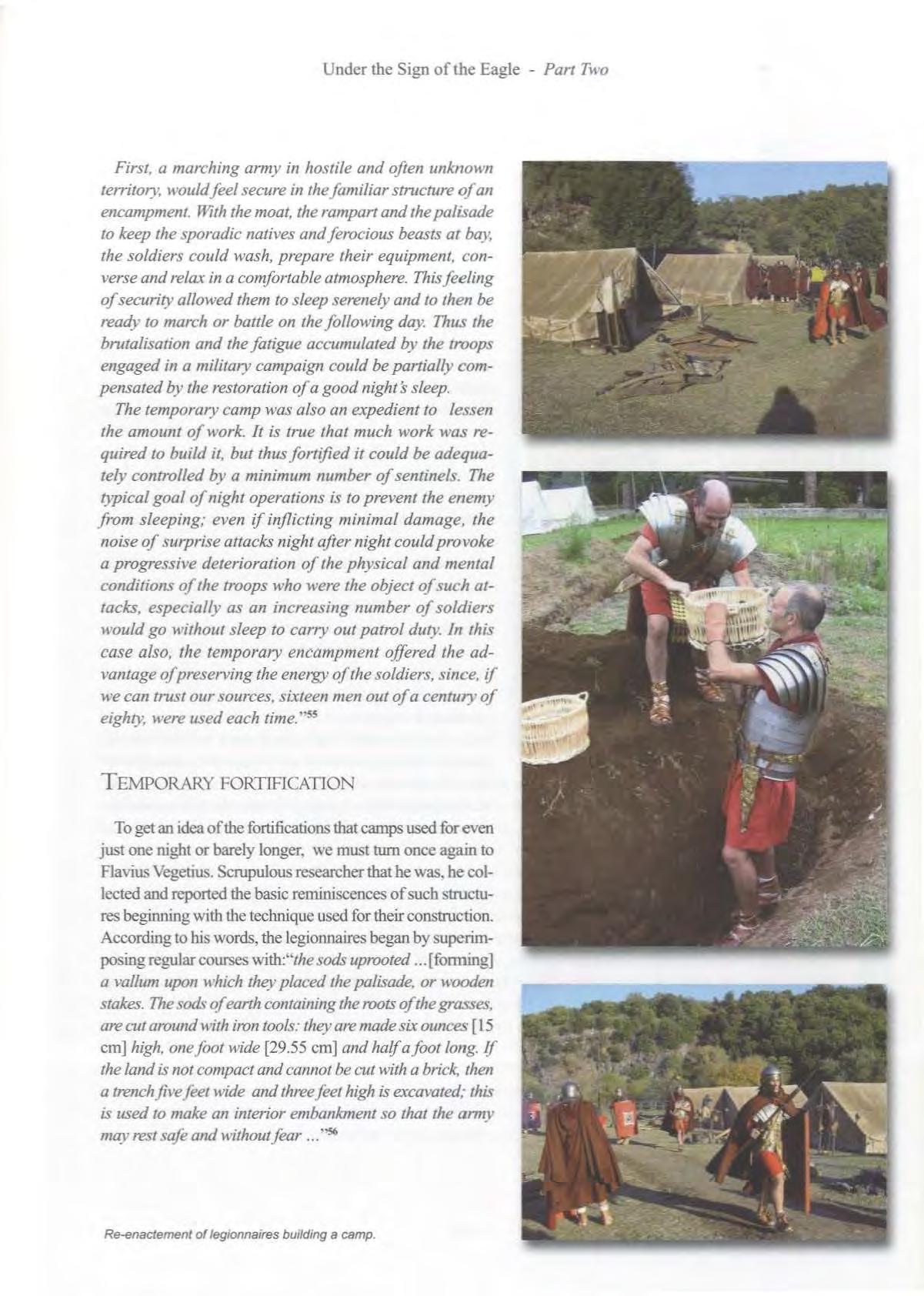
Regarding its construction:"it has been stated that the temporary encampment was a guarantee from the tactical aspect,for ifthe Roman troops were defeated on the field of battle they could always seek reji1ge in the camp and prepare to fight another day. But this could occur only ifthe defeated troops had an intact camp nearby, little likely, since defence fortifications were usually ignored once the camp was abandoned. However, this observation is valid iftaken in a more subtle manner: nothing is more difficult that to transjom1 defeat into an orderly retreat, avoiding disorder(v flight, thus the camp ofthe preceding night could be the natural point of reassembly, ready to once again deplo_v the army in an orderly manner.
In this manner the Roman temporary camp united the tactical advantage of a bivouac with the ease offered by lodgings, in addition to having a guarded perimeter that, if needed and with a little more time and work, could be transformed into a fortification. The typically Roman institution of temporary camp was therefore a determiningfactor for the strength ofan army, whose peculiar nature consisted in its elastic resistance in moments of effort. " 51
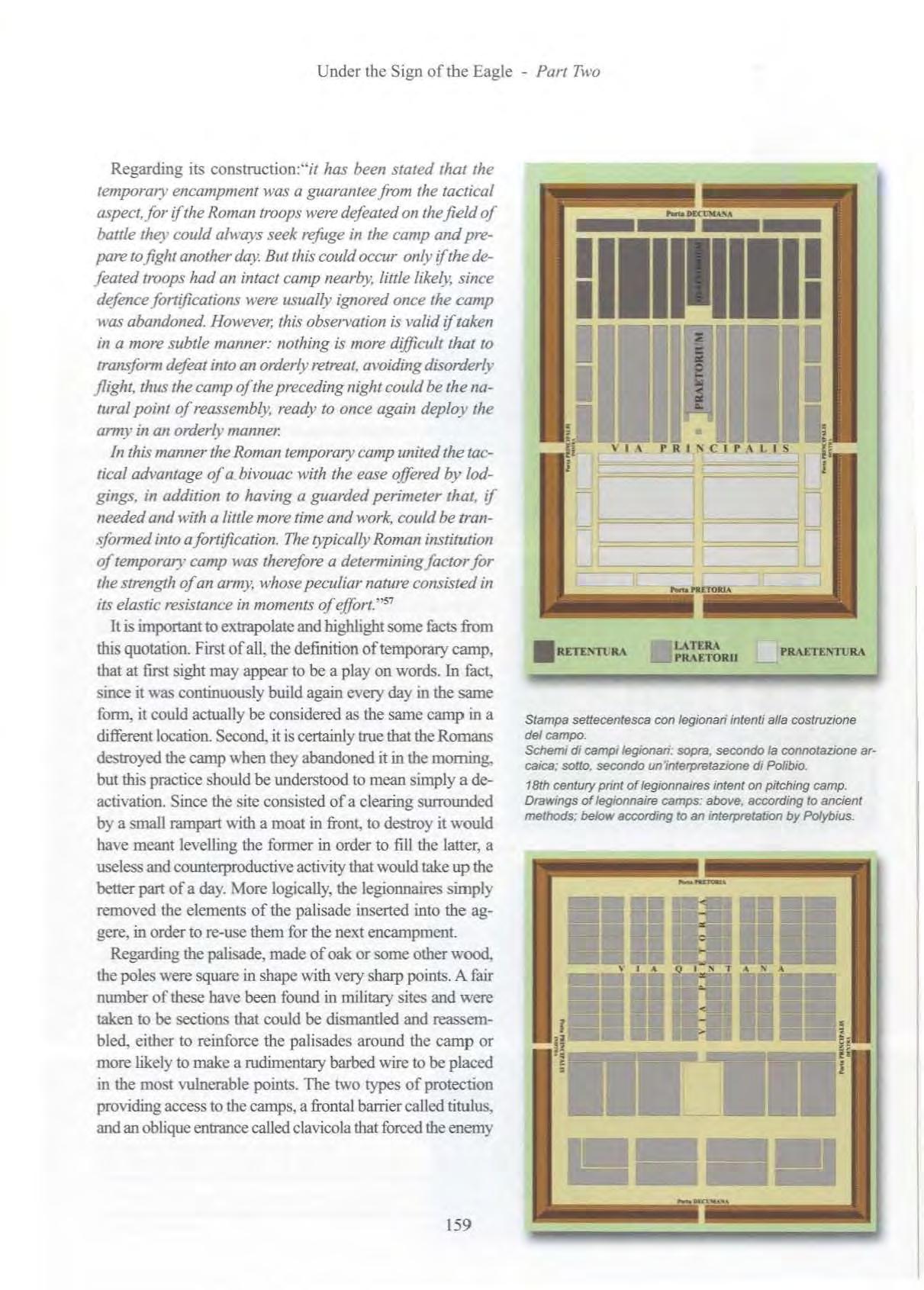
It is important to extrapolate and highlight some facts from this quotation. First of all, the definition of temporary camp, that at first sight may appear to be a play on words. In fact, since it was continuously build again every day in the same form, it could actually be considered as the same camp in a different location. Second, it is certainly true that the Romans destroyed the camp when they abandoned it in the morning, but this practice should be understood to mean simply a deactivation. Since the site consisted of a clearing surrounded by a small rampart with a moat in front, to destroy it would have meant levelling the former in order to fill the latter, a useless and counterproductive activity that would take up the better part of a day. More logically, the legionnaires simpl} removed the elements of the palisade inserted into the aggere, in order to re-use them for the next encampment.
Regarding the palisade, made of oak or some other wood, the poles were square in shape with very sharp points. A fair number of these have been found in military sites and were taken to be sections that could be dismantled and reassembled, either to reinforce the palisades around the camp or more likely to make a rudimentary barbed wire to be placed in the most vulnerable points. The two types of protection providing access to the camps, a frontal barrier called titulus, and an oblique entrance called clavicola that forced the enemy to expose his left flank, similar to the older porte scee, required a strong palisade to prevent forced entry, but one that could be dismantled. 58

Thus reactivation of a camp that had been abandoned shortly before would have been extremely rapid, as it was sufficient to reposition these poles. And it is also possible that in the event of a retreat or routing in unknown territory the commanders might want to bring the legionnaires back to the last camp, no further for obvious reasons than half a day's march and that the passage of the previous day had levelled the ground and made the march less difficult. It should also be pointed out that the location of a castra was not decided during the march, but carefully selected by scouts who took into account that it could not be further removed than the normal distance travelled daily, that it had to be flat and, most important, adjacent to a source of water, a lake or a large spring. Although our most detailed information is from a later era. the basic uniformity of the practice allows us to adopt it also to outline the procedures of the Republican Era.
The Camp Layout
The first duty was to carefully plan an itinerary that provided such opportunities, then to identify the best site day after day. This task was the responsibility of various officers and of the metator, who applied the same principles and criteria as for a permanent camp, also considering, when possible, that the area not be overlooked by a hill or other height to avoid coming under fire. The ideal would be a s lightly inclined area that favoured the natural flow of the waters and sewage and provided better ventilation. 59 A good defmition of the legionnaires and technicians responsible for preparation of the camp and of their respective tasks is the following:"initially, the objective during expeditions was to have a solid camp each night. The metator, who preceded the troops, had to find the right site and then split up the units; the geometer (/ibrator) checked the horizontal features ofthe space and his skills were often utilised also to help the artillerymen and, for example, to dig canals; the surveyor (mensor) marked the location ofthe dormitories, delimited the surfaces belonging to the legions and could replace the architect •'60
As for the actual activities involved one may assume that, approaching the end of the march, but more likely around its middle, a tribune and several centurions would already have reached the site, much forward in respect of the head of the legion, or of the first legion in the event of a consular army compose d of two, perhaps at the same distance as the advance guard. There was therefore ample time to observe the surroundings, evaluate any danger, ascertain the suitability of the particular site in respect of the previous one, and given the absence of troops and wagons, to perceive even the slightest suspicious noise or absolute silence, even more suspect. Even Flavius Josephus agrees regarding the extreme attention given to the location of the camp and the scrupulous care observed in selecting an optimal location, levelling it and tracing its perimeter. Everything was minutely regulated and approved from the moment the march began at dawn.
A residual echo of the meticulous care given to the correct installation of the castra can be deduced from the ordinances mentioned by Vegetius Flavius, at a time when these structures were rarely made. The famous writer of military tre-atises stated, with some nostalgia, that:" in the vicinity ofthe enemy, the camps are always in a protected area, where there is an abundance of wood, hay and water; furthermore, ifa long sojourn is expected, select a healthful area. And avoid any hills in the vicinity that, ifoccupied by the enemy, mayfacilitate his attack. Care should be taken to ensure that the camp is not subject to anyjloodingfrom torrents, that may cause problems to the troops ... •'6• He continues saying that:"they must also avoid that in the summer the water may be contaminated or that healthy water is far; that in the winter there is no lack offorage or wood [and] that it is not in areas that are ruined or offthe road and, in bringing the siege to the enemy, that the exit is not difficult; that no arrows can be hurledfrom heights by the enemy. .'>fil
Reduced to simple rules, these precautions may thus be summarized:
-+ IDENTIFY THE SITE ACCURATELY, BY THE CHARACTERISTICS MDITIONED ABOVE
-+ E'\SI.JRE THE AVAILABILITY OF POTABLE WATER
-+ DiSL"RE THE LAND CA N BE DEFENDED
-+ DELIMIT THE AREA
AAt that point a legionnaire surveyor placed in the centre of the selected site a topographic instrument, the groma, consisting of four plumb Lines, and looking through it staked 90° angles. This provided precise orthogonal directions to trace the perimeter of the camp and its interior roads, delimiting the spaces to pitch the tents. The central point of the camp was also called the groma.63 In later eras the groma may have been replaced by Hero's dioptre, much more precise and insensitive to the wind. The instrument also allowed them to pitch camps that were not necessarily orthogonal, a configuration confirmed by some residual traces.
These stringent limitations, especially in rough areas, considerably limited the areas suitable for the installation of a castra. Which contributed to reducing the normal range of the daHy march: and, in fact, it would be absurd to suppose that the exhausting work of advancing upward with the weight of equipment should then be accompanied by an increase in the distance to be marched because of a lack of suitable sites! To have an even vague idea of the equipment that a legion had to bring with them, it is sufficient to remember that they needed, first of all, more than 500 tents, some of which were quite large: all with heavy supports and accessories.

The Legionnaire Tents
Roman writers of treatises specified the form and the characteristics of military tents, whose sizes varied according to destination. The tent of the legionnaires, called papilio, and that in many aspects is similar to the modem Canadian tent, was formed by two inclinations, similar to a roof, supported by a wooden trestle. Wooden stakes measuring approximately 40 cm were used to fasten them tQ the soil using special cords. Their square layout measured 12 feet per side, 10 interior and 1 exterior for anchoring, covering 9 square meters with a maximum height of approximately 1.80 m and 1 m high along the sides.
Access was provided by two movable pieces of fabric: in this tent lived eight men, contubernium, with all their personal effects and weapons, in close proximity. Since its layout was 9 sqm, or 3x3 m, placing 4 men with their heads facing the two opposing sides, each man had an area of 70 cm. And, considering that their average height exceeded 1.60 m, their legs had of necessity to intertwine! It was impossible to go out during the night without disturbing the entire group: this only if their objects were hung along the frame of the tent, so as not to occupy any space on the ground. But reality must have been much worse, perhaps to purposely frustrate any laziness.
The fabric was cowhide, a thick leather re- t sistant to bad weather, but also the least suited to ventilation. Since at least 25 of these hides were required for each tent, when added to the stakes and ties the total weight was approximately 30 kg. All the tents, even underestimating their weight, came to about twenty tons, requiring at least fifty wagons to transport them.
Scena del/a Colonna Traiana ne/la quale si distinguono delle tende di un campo legionario.
Ricostruzione delle tende in un campo legionario. Stampa settecentesca che mostra la disposizione dei soldati sotto le tende da campo. E da considerarsi praticamente immutata dall'epoca romana.
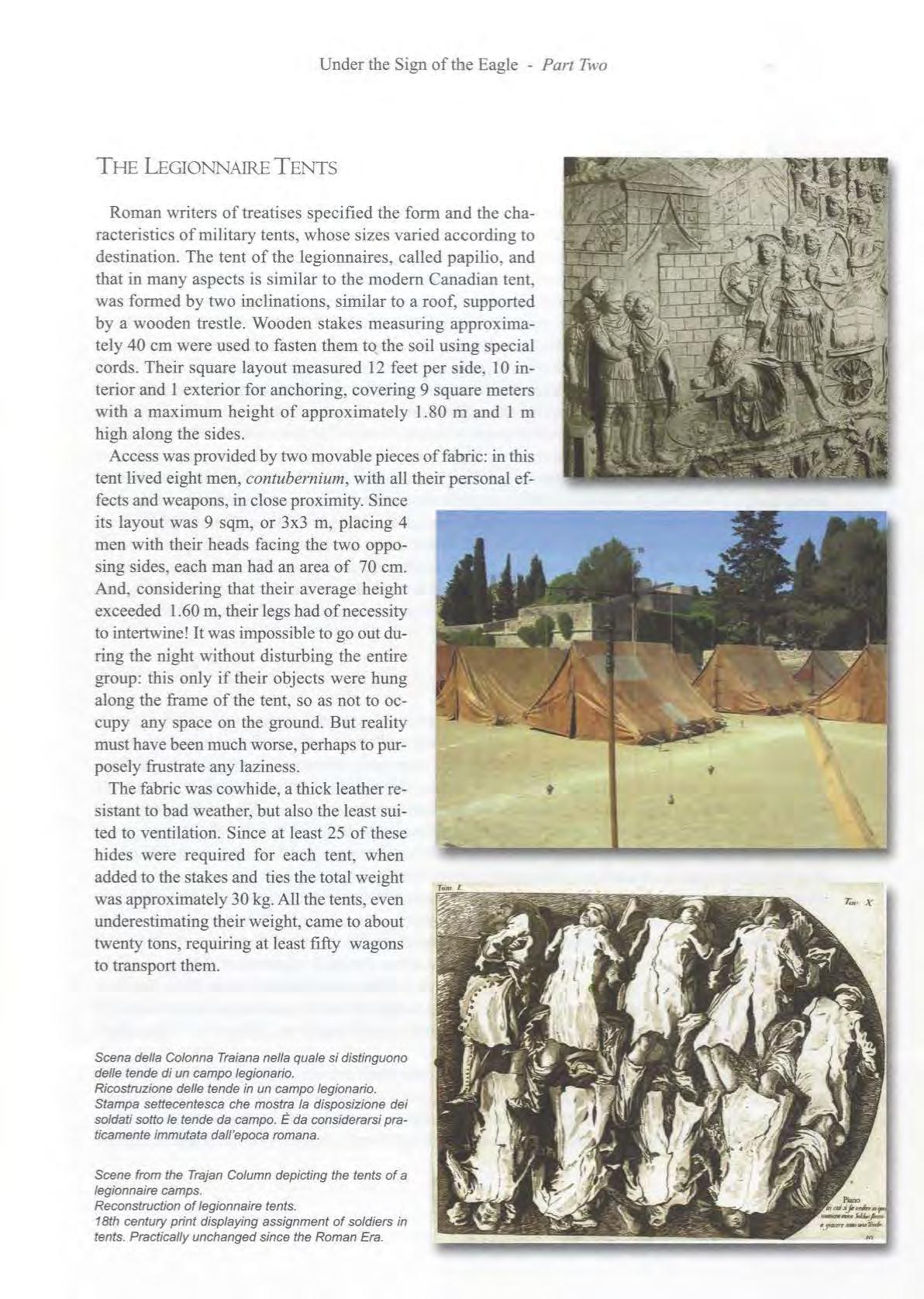
Seasonal Camps
If the above was obligatory for temporary camps, known as subita tumultaria castra or aestiua, the perimeter fortification for all the others had even greater and more numerous characteristics, especially when they were in enemy territory or near the enemy. In all these circumstances the individual centuries were ordered, according to the division of tasks established by the commanders of the camp and by the princeps, to station themselves along assigned segments, and after placing all the shields in a circle and the baggage around the standards, to begin the excavation of the moat, without putting down their individual weaporns. The triangular shaped moat with the apex at the bottom, was nine, eleven or thirteen feet wide at the top, which could increase to seventeen if there was the risk of particularly violent enemy attacks. The preference for an odd number measurement must be related to the need to leave a width of one foot at the bottom thus simplifying the geometric subdivision. When the excavation was finished, branches and pointed trunks were placed on the excavated soil bordering the trench, forming an aggere or agger. 64
If the camp was to be used as a forward base for operations in enemy territory and had to remain in the same place for a long time, it was defined as castra stativa. These were heavily fortified camps often surrounded by thick crenellated masonry walls, interspersed by slightly jutting cylindrical towers. Even when the castra stativi replaced the wooden huts that in turn bad replaced the tents, with masonry structures, the general layout was more or less the same. It simply became larger as it bad to contain, in addition to the above constructions, also the enormous stables for horses and other animals, immense storage sites for food, forage deposits, shops and in some cases, even iofmnaries.
Dimensions Of Legionnaire Camps
In addition to the two types mentioned, there were a great many other types of Roman camps, though the general layout remained the same. The factor common to all was the constant of usage, something that never failed in field operations, as reported by Polybius for the Republican Era and Flavius Josephus for the Imperial one. It was Polybius who wrote, with great abundance of detail, of the characteristics and dimensions of the castra that during his era had to accommodate even a consular army of two legions. Tbough:"the manuals for laying out camps still provided instructions on how to pitch camp for Jour legions ofan army commanded by both consuls. ThePolybian description oftheRoman camp ofthe era has led to a vast literature from the XV century onward. Walbank maintains that the most convincing explanation so far is that ofP. Fraccaro, who believed that Polybius used a Roman vademecum containing the layout of a typical camp. The 'typical' camp was still the camp for four legions; but Polybius describes only half The other half is identical, but reversed (arranged 'back to back'), having only the base line in common with the first. Writes Polybius: «Whenever the two consuls with theirJour legions are united in one camp, we have only to imagine two camps back to back, thejunction beingformed at the encampments of the extraordinarii infantry of each camp who are in the rearward agger of the camp. The shape of the camp is now oblong, its area double what it was and its perimeter equal to one and one half»". 65
A dimensional idea of a camp for large units is also provided by Hyginus who generally still follows the traditional canons and prescriptions. In his opinion a large encampment capable of lodging the regular army, the auxiliaries, the cavalry and even the contingents of naval forces, had to have a rectangular layout and measure m 687 x 480 m. Inside the units were positioned differently and, even more curious, legionnaires much more amassed, to the point ofhaving only a third of the space they had in the Polybian encampment. 66 This last observation appears extremely significant, as it proves that the Romans were not at all inclined to increase the dimensions of their castra beyond a certain limit, perhaps because they became indefensible or, more likely, because the correct layout required extremely rare environmental characteristics. From a practical point of view, we have the following empiric formula for the size of the camps:
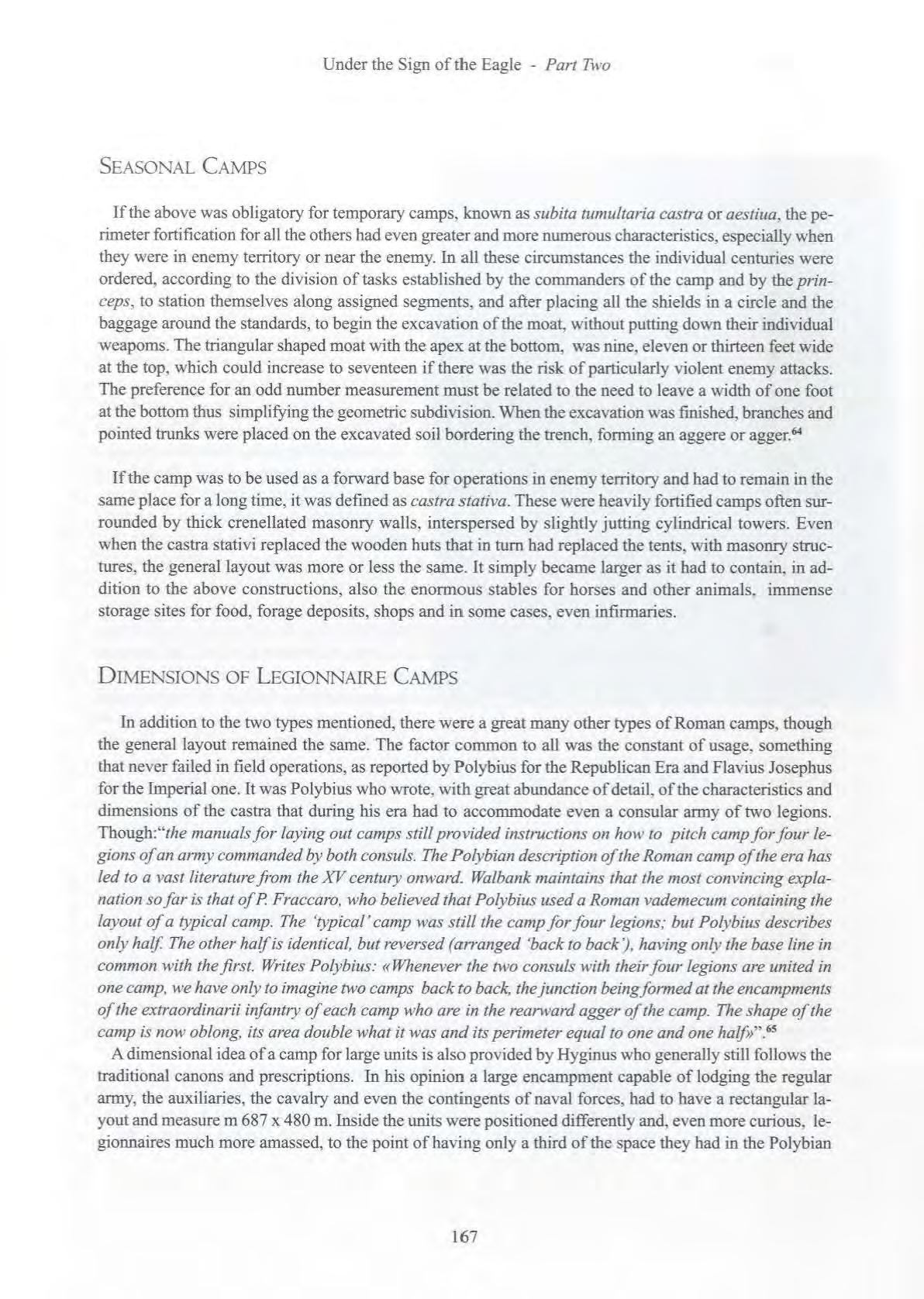
1=200-v'C L=l.5 l where the length in feet of the short side of the camp, I, must be equal to 200 times the square root of the number of cohorts to be lodged, while the long side, L, must be equal to one and one half times the short one. Apart from the restrictions imposed by size there were also those connected with the availability of water. Given the presence of so many men and animals, the immediate vicinity of water was essential. In some exceptional cases, when it was not possible to make camp on the shore of a river, a common solution, they built canals, often underground, to connect the camp to the closest spring and to thwart any surprises. These almost always led to large cisterns as according to the living habits of the Romans water was precious not only for drinking. 67 A base camp, therefore, had to be able to accommodate two to four legions and very rarely and only for extre- mely serious strategic reasons could it be located far from a river. The essential condition for this was absolute control of the surrounding territory, as they had to supply water using barrel wagons.
In questa pagina: veduta intema del/a Piscina Mirabilis, la cisterna che a/imentava la base navale di Miseno.
Ne/la pagina a fianco: rievocazione di /egionari presso un fiume.
On this page: interior of the Piscina Mirabilis, the tank that supplied the naval base of Miseno.
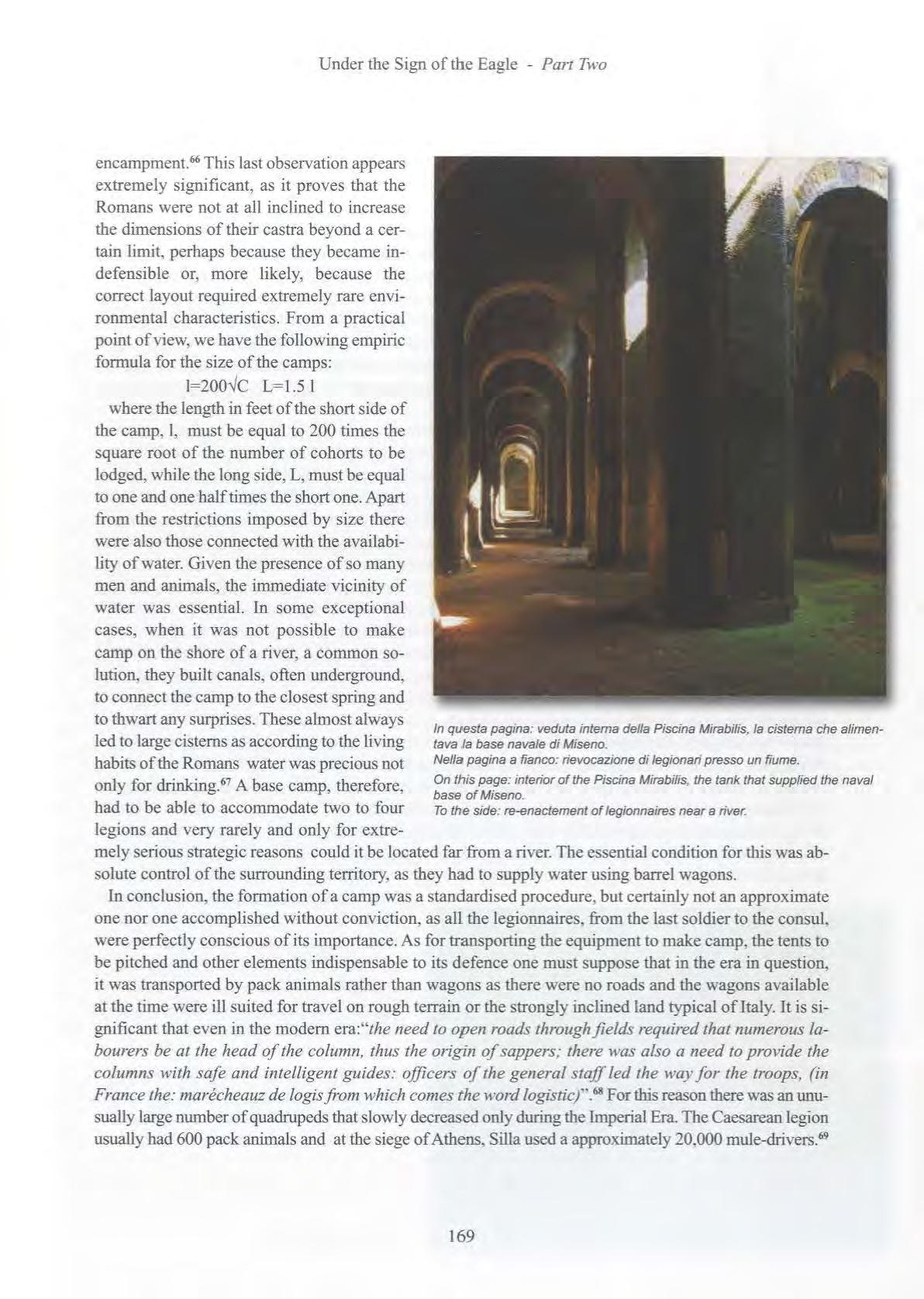
To the side: re-enactement of legionnaires near a river.
In conclusion, the formation of a camp was a standardised procedure, but certainly not an approximate one nor one accomplished without conviction, as all the legionnaires, from the last soldier to the consul, were perfectly conscious of its importance. As for transporting the equipment to make camp, the tents to be pitched and other elements indispensable to its defence one must suppose that in the era in question, it was transported by pack animals rather than wagons as there were no roads and the wagons avaHable at the time were ill suited for travel on rough terrain or the strongly inclined land typical ofltaly. It is significant that even in the modern era:"the need to open roads through fields required that numerous labourers be at the head of the column, thus the origin of sappers; there was also a need to provide the columns with safe and intelligent guides: officers of the general staff led the ·way for the troops, (in France the: marecheauz de logis from which comes the word logistic)".68 For this reason there was an unusually large number of quadrupeds that slowly decreased only during the Imperial Era. The Caesarean legion usually had 600 pack animals and at the siege of Athens, Silla used a approximately 20,000 mule-drivers. 69
ARMY ON THE MARcH
To conclude with the section on camps, surely the most original Roman military structure, another fundamental aspect in the s tu dy of the legions concerns their method of marching and relative speed. The successes of war and the deterrence they succeed in imposing were very often based on these two factors. Unfortunately there has been much misunders t anding on this issue, confusing both time and space, almost as if the speed of march o n the excellent consular roads could be equal to the speed maintained prior to their construction. Or imagining large units moving at a rigidly cadenced pace, something that only happened in the last few centuries. It is because of these misinterpretations that it is essential to provide addition al dat a in order to tru ly assess the effective and extraordinary capabilities of t he Roman army on the march.
Up to the advent of the railway and its use by the military 71 , between the speed of travel ofNapoleon's armies and Caesar's l egi ons, very little had changed as physical resistance to fatigue, hunger and thirst, as well as muscle p ower, are physiologically unchangeable. With this in mind, and according to classica l sources, Roman troops left after a very early breakfast, long before dawn, which in the summer woul d be around five our t ime, and marched for a lmost half a day. Considering that in the summer the day lasted about sixteen hours, they m arch ed until th irteen hundred hours approximate ly. The rest of the day was used to build the camp, and for other military and personal needs. 71 Which would mean at least seven-eight hours of marching, interrupted perhaps by brief stops: but how much distance was actually covered in such an interval? And more important, how much distance could a large army cover \vith all its equipment and appurtenances? Before getting i nto specifics, we m ust remember that when a colurnn:"of marching troops is composed of various mixed arms, the pace can only be regulated to a certain extent as continuous stops and delays are inevitable as are backward movements and efforts to catch up. These different marching rhythms tend to tire the troops, ham1 the horses and needlessly lengthen the duration of the march". 12
The principal and most common expedient to avoid such inconveniences was to stagger the different units . leaving a moderate space between one group and another to act as buffer, even at the risk of l engthening the enti re column. We co ul d say "that the satisfactory progress ofa march depended on the progress kept by the head of the column. 1fthis should inconsiderately hasten or slow its pace, the different groups lose their distances and clash into each other. Thus at the beginning of a march the head of the column must walk rather slowly to give time to the units that follow to enter the given column at the right distance; when crossing a strait, residential areas, narrou· bridges, etc it must quicken its pace to prevent stumbling and must slow down again at some distance from the strait so as not lose distances. In climbing, one must prevent the head of the column from slowing down excessively and avoid going too fast in the descent. If they do not prevent the soldier from slowing down in ascents because ofthe greater effort he is obliged to make, and to moderate speed in the descents, this would shorten or lengthen distances in the marching columns. tiring the troops and leading to inevitable disorder " 73
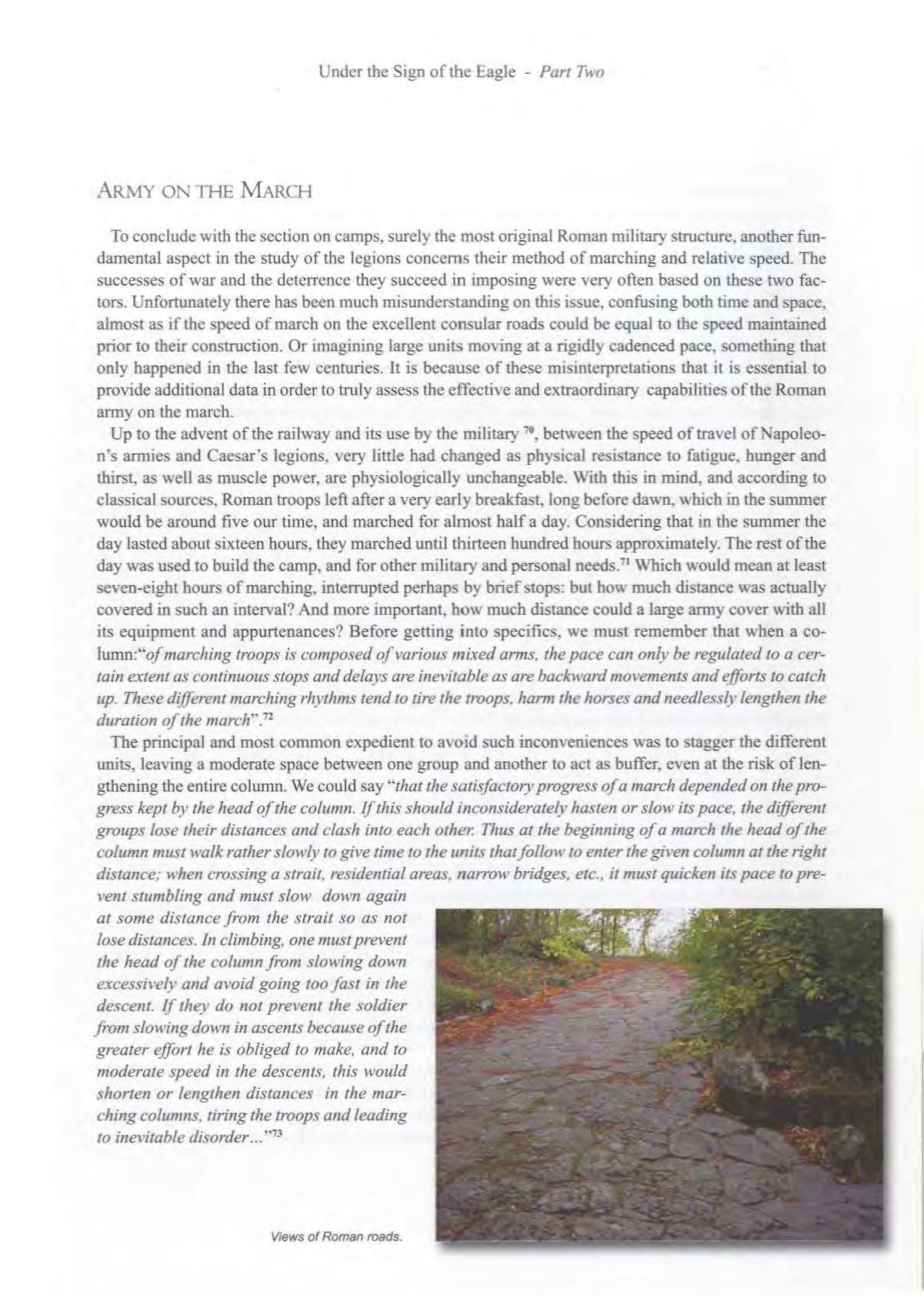
Given this unquestionable, historical and timeless constant of all marching armies, in order to reply to the two queries formulated before we must assess the traditional marching configurations of the Romans, from the time they leave their camp to their arrival to the following night's accommodations. According to Polybius once again, after the third sound of the trumpet, the first members of the long column begin marching:" in the front are usually placed the extraordinaries; and after these the right wing of the allies with their baggage and that ofthe extraordinaires. Their march is followed by the first legion with its baggage also; the second legion follows with their baggage and that of the allies, who are in the rear; the last in the order of march is the left wing of the allies. The cavalry now protects the rear of the corps to which it is attached, marching on the flanks ofthe beasts that are loaded with the baggage, keeping them together in due order and protecting them. When an attack is expected to be made upon the rear, while all the other bodies maintain their formation, the e.xtraordinaires of the allies are posted from the head to the rear of the column.
Of the two legions and the two wings of the allies, those that are on one day foremost in the march, on the following day are placed behind; that by thus changing their rank altenzately all the troops may obtain the same advantage in their tunz, of arriving first at water and at forage. There is also another formation which is used when immediate danger threatens, and the march is made through open country.
The hastati, the principes and the triarii are ranged in three parallel lines; with the baggage ofthe maniples in front, behind the first maniples those of the second, behind the second those of the third, so that the beasts ofburden are alternated with the maniples With this marchingformation, ifthere is a danger, the maniples turning either to the left or the right advance from the place they occupied among the baggage, toward the front of the enemy. Thus by a single movement and at great speed the infantry forms for battle, except only that the hastati are perhaps obliged to make an evolution, while the beasts of burden and those that follow, thrown into the rear of the infantry ready for battle, are covered by them from all danger". 74
Apart from the technical data and the reasons behind such scrupulous orders, what seems obvious, as previously for the camp, is that nothing was improvised, especially when marching through enemy territory. The movement of a consular army of two legions, such as the one just described, was a mathematical procedure with pre-established and mandatory configurations and movements, suitable both for normal and high risk situations. As for the role of the cavalry, this can generally be equated to that of shepherd dogs in respect of a flock: it prevented their dispersal while protecting them from any attack from wolves. Attacks, militarily speaking, of high frequency and low intensity. The cavalry was also entrusted with short range tactical reconnaissance.

In this regard Flavius Vegetius Renatus stated:"when the army was ready to begin movement, the commander sent his trusted and experienced horsemen with the best horses to reconnoitre in front, in rear and on the right and left lest he should fall into ambushes ... The cavalry march offfirst, then the infantry; the equipment, the baggage, the servants and carriages follow in the centre and part of the best cavalry and infantry come in the rem; since it is more often attacked on a march than thefront .. .''15
Apart from the use of low threat or high risk type of marching described by Polybius, the pack animals were divided into separate groups interspersed by maniples. This created safe areas that prevented close contact among the different groups and avoided terrorizing the animals during a not improbable and unexpected attack. This arrangement may be compared to the concept of water-tight compartments on board ships, when heavy doors are used for any area accidentally flooded to prevent the water from entering other compartments and risk of losing the ship.
The rotation of legions at the head of the column permitted a more homogeneous foraging and water supply, but it also ensured an equal distribution of marching fatigue and of preparations for the camp.
Those who advanced first over unprepared land, typical of manoeuvres off-track, were forced to make a significantly greater effort than those following, as the latter found the road free of vegetation and other obstacles as well as a well-beaten trail. Also, by arriving several hours ahead, for such was the difference between the two ends of the column, they could begin the work required to set up camp. Regarding the availability of water along the route, it is implicit that the itinerary would consider this fact, as far as was possible, not so much for the men, who with careful rationing could in some manner make do, but for the numerous animals who could not sustain the fatigue or the heat without frequent and abundant water. Reason that forced them, in the event of a total absence of water, to camp where there was sufficient water, independent of the distance, or from a certain time on, to use cistern wagons, the various types of which we see illustrated in classical iconography. The advancement could never be protracted to the point of bringing men and animals to the limit of their strength. This would not only have created serious problems in making camp, but if attacked would have been the prologue to an irreparable defeat.
Length And Types Of Stages
The stages of a march were systematically rather inferior than superior to the average marching potential of the legionnaires as they always had to have sufficient physical energy to repel an attack. This pressing need explains the reason for the closely located succession of night camps to the point that a man without a heavy burden would need only four or five hours to go from one to the other. And also explains why each legion was responsible for building the camp only on alternate days, while the other was responsible for defence.
We have often taken for granted the ability of Roman military formations to march even 30 km a day, and it is possible that such an extraordinary result may have been, in rare cases, actually achieved. More attentive scrutiny however reveals that that such rapid advancement could occur only along flat desert terrain or structured roads, without baggage and without heavy siege equipment. One of the reasons that Roman roads were the greatest military infrastructure in history is that they were intended to accelerate the movement of the legions. But this meticulous road network did not exist during the Republican Era, especially in the territories of Central Europe, and travel of even a few miles involving considerable difficulties for a group of merchants,

Una coorte in posizione statica led to immense ones for an armed force and its numerous supply wagons. The difficulties of such travel can be deducd from one particular episode. In the ll century B.C. in order for Cato to bring an olive press that had cost him 348 cestercians from Pompeii to his farm, about seventy miles away, he spent 280 for transportation! An enormous cost specifically because of the aforementioned difficulties. A legion certainly had to transport much greater burdens.
A cohort in static position.
Static And Dynamic Length Of An Army
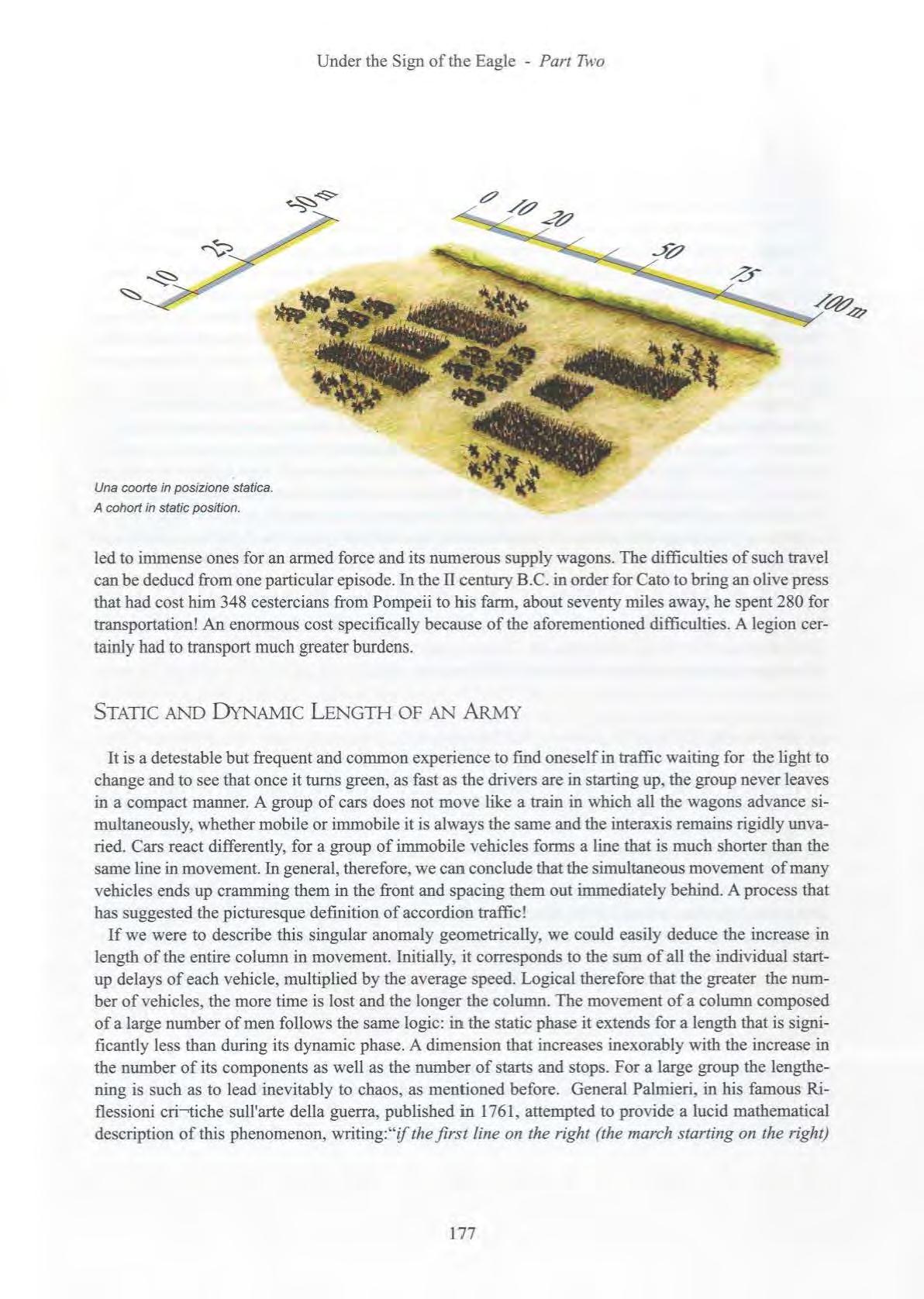
It is a detestable but frequent and common experience to find oneself in traffic waiting for the light to change and to see that once it turns green, as fast as the driv ers are in starting up, the group never leaves in a compact manner. A group of cars does not move like a train in which all the wagons advance simultaneously, whether mobile or immobile it is always the same and the interaxis remains rigidly unvaried. Cars react differently, for a group of immobile vehicles forms a line that is much shorter than the same line in movement. In general, therefore, we can conclude that the simultaneous movement of many vehicles ends up cramming them in the front and spacing them out immediately behind. A process that has suggested the picturesque definition of accordion traffic!
If we were to describe this singular anomaly geometrically, we could easily deduce the increase in length of the entire column in movement. Initially, it corresponds to the sum of all the individual startup delays of each vehicle, multiplied by the average speed. Logical therefore that the greater the number of v ehicles, the more time is lost and the longer the column. The movement of a column composed of a large number of men follows the same logic: in the static phase it extends for a length that is significantly less than during its dynamic phase. A dimension that increases inexorably with the increase in the number of its components as well as the number of starts and stops. For a large group the lengthening is such as to lead inevitably to chaos , as mentioned before. General Palmieri, in his famous Riflessioni cri----tiche sull'arte della guerra, published in 1761 , attempted to provide a lucid mathematical description of this phenomenon, writing:"if the firs t line on the right (the march starting on the right) makes its first step one foot long, the second line must wait for the first to leave enough space to take an equal step, the third is forced to wait for the first and the second, and so consecutively all the others; so that the delay always multiplies and increases up to the end, resulting in two great inconveniences that we still note today: the first is the initial lengthening of the battalion, the second that it cannot advance together, in fact while one part is marching, the other is immobile: inconveniences that become increasingly greater the more numerous the number of troops undertaking the march " 76
Returning to the example of the vehicles stopped in front of the traffic light, to be even clearer, imagine there are a certain number of trucks, tractors and even horse drawn carts between the stopped vehicles. The simultaneous movement of the entire structure would be conditioned by the slowest and bulkiest of the vehicles, thus, if we were to take a dynamic measurement a few minutes after the light turns green, the total space occupied would not only be incomparably greater that its static measurement, but also much greater than if there were automobiles alone!
This dishomogeneity of the various components of a marching army contributed greatly to its length and its slowness, to a degree even greater than that caused by the number of the troops. These penalizing consequences stimulated entire generations of commanders to make ingenious logistical corrections and tactical improvements to reduce that deleterious characteristic that was further exasperated by the diversification of armaments. The only solution was the introduction of a cadenced march, but this innovation can in no way be associated with the march of the legions, as it was developed only in the XVIII century.

Ordinary March And Cadenced March
When we speak of marching, our thoughts are immediately directed to the well known one-two cadenced rhythm typical of military units of any type and size. This is not only the emblematic feature of the military but also the most obvious manifestation of the obtuse de-humanisation of an institution that subjects even walking to a mechanical and uniform system. Facile rhetoric aside, reality is quite different and the exclusion of that commonplace and historically incorrect belief, imposes yet another important digression. In the preceding paragraph we provided a detailed explanation of the dispersal and breaking up of a marching column and its deleterious tactical consequences. The unceasing efforts at first to decrease and then suppress this deficiency finally led to the innovation of the rhythmic step, a method that may have been implemented as early as the Middle Ages, for brief distances and perhaps using the roll of drums. And it was by imposing two distinct commands, first to the right leg and then the left, in accordance with a precise temporal rhythm, that the cadenced or rhythmic march was developed.
The cadenced march was based on the concept that if every soldier moved the same leg simultaneously with that of the others, and at an identical angle, he would no longer have to wait for the completion of the same movement by the soldier in front. In this manner the entire unit would be transformed into a single compact and synchronous body, or, to return to our analogy, the column of cars would be transformed into a rail convoy! In this manner the static and dynamic obstructions of any military unit, large or small, would coincide and there would no longer be an accordion effect.
Some Egyptian models of military formations on the march, and numerous Roman bas reliefs of the Classical Era with a military subject, show groups of warriors aligned, all with the same leg raised, obviously intent in completing a step. The synchronism of the scene has led many scholars to believe that rhythmic marching step was used even at that time. In reality there are other friezes, even more ancient, depicting various slingsmen, archers, swimmers, all in the same position, without anyone supposing that they were about to hurl stones and darts simultaneously, nor that they were swimming synchronously as in our very modem artistic gymnastics!
The explanation is quite simple. This was merely a conventional illustration technique, that, in addition to being an unquestionable simplification for the executor, was used to indicate a large number of men intent on the same task at the same time, but not necessarily synchronously!
In fact, the idea of having the soldiers of an entire unit march by moving their legs not only simultaneously but in perfect synchrony and in a geometrically equivalent manner, a mode technically defined as cadenced march, is rather recent and was introduced at the end of the eighteenth century. On this topic General Ulloa stated that:"the invention of the rhythmic step, introduced in the XVlll century, is justly reputed by tacticians as having contributed the most to the advancement of the art ofwar. In fact, as the soldiers moved uniformly, they maintained order within lines, could advance more comfortably and cover more space in less time; wavering was avoided and an entire battalion moved as a single body. By maintaining the rhythm and step soldiers on a fast march can reach the enemy in an orderly manner and engage the formation in its entirety. This general effect and this union offorces ensures success in combat "77
Concerning the meaning of formation, General Palmieri noted that this may be:" a composite of lines and rows; that the line is a series of men situated shoulder to shoulder and the row a series of men front to back; as a result the soldier is in formation, if he maintains his line and row. As soon as he loses one or the other, he is out offormation , and the entire body becomes disordered " 78 When the Romans marched they could not remain in formation in the strict sense because they were not familiar with the rhythmic step march, yet to come. Thus any formation of theirs was subject to the undulations and lengthening mentioned. In this case also, where the many illustrations left by innumerable artists, including some of the great masters of the Renaissance, depicted Roman formations marching like geometrically defined and regular blocks they do so, inevitably, supposing them not while marching but preparing to do so, that is, in formation line-up. Static, not dynamic, representations of armies grouped and fractioned into smaller units, with unquestionable historical prevision but alas with just as unquestionable geometric idealisation!

Reality was very different and less spectacular, and in envisaging the space occupied by a march, we are not far from the truth to suppose it to be at least three times longer, the formation being equal, than a formation with the same number of men, but standing still.
Daily Advancement Of The Legions

Having clarified the methods of marching of a large Roman unit and its consequent highly variable length, we still need to evaluate its manner of travel and the distance it could cover in a day's march. Or at least the context of its excursion. Which obviously means verifying the speed of march under different conditions. Now, although there is no lack of sources in this regard, these sources tend to provide the spectacular rather than the usual, similar to sensational journalism, and this is something to be considered. Furthermore, since speed is a sort of physiological performance and as such not subject to significant changes in the course of millenniums, it would be logical to correlate ancient performances with modem ones. much less arbitrary and uncontrollable, if for no other reason than the correctness of measuring time, independent of the apparent course of the sun. Thus we can submit present some reliable data concerning the frequency of the step, the basic requirements of speed today as it was during the Roman era. The only difference consists in considering this value, after the introduction of the rhythmic step, as a specific number in the unit of time, while in the past it was only an average, since it was difficult to determine precisely the duration of an hour. On daily distances however the difference is not overwhelming, thus allowing the above interpolation.
Once again we turn to General Ulloa:"there arefive ()pes of steps: the school step, which is 2 feet in length, and 76 are taken per minute [equal approximately to 3 km/h); the ordinary step, of the same length as the school step, and 100 ofthese are taken per minute [equal to approximately 4 1.:-m/h], which is the most comfortable step, because it is mans natural step, though longer andfaster; the charge step, faster than the ordinary one, and 130 are taken per minute [equal to approximately 5.1 km/h); the gymnastic step, which is 2 feet 2 inches, and is taken at different speeds, and 175 can be taken per minute [equal to approximately 7 km/h); finally there is the nnming step, which is the same as the gymnastic step, but has the greatest speed [approximately 8 km/h).
The infantry moved at school step in the elementary exercises of the soldier and in the platoon and division school; at ordinary step in the battalion and line formations; at charge step and gymnastic step in the fast lines. But it would be useful for the soldier to practice this step in order to maintain it for a long time and use it in all the evolutions and movements on the field ofbattle'>79 Thus, even:"with these data we could calculate exactly the time requiredfor an infantryman to go a certain distance; noting that the nature ofthe different terrains and the frequent interruptions in movement modify the results of the calculation. But experience provides the following data.
A good and well exercised infantry can advance 300 metres on the field ofbattle; marching in close order, in 4 minutes; running in 2'5"; marching in open order, in 3'40"; and running 2'2". On soft terrain in 4' with the ordinary step; running, in 2'5" with the .first array, and with the second in 3'40" with the ordinary step, and in 2'40" with the running step.
When the terrain is uneven and inclined, the speed ofmovement cannot be accurately assessed as it depends on the different inclinations of the land that may accelerate or slow movement.
On firm and compact terrain the infantry can advance 2 miles in one hour, and 4 miles in 130: remaining united and orderly; in open order it requires 55' to advance 2 miles and 120'for 4 miles. On soft and uneven terrain, in the first case the time required is 60' and and in the second 55' and 120' " 80
Obviously the speeds given by the general, even when referring to off track advancement, presuppose a suitable terrain, not only compact, but also free of vegetation and relatively regular and straight. Not incidentally it was in order to avoid such rough terrain that the Romans built their extraordinary road network. Where such roads did not exist it became difficult to train a soldier to march, as he was also:"carrying his weapons, his clothes and even his breadfor several days; thus he is to be exercised walking with this weight. Lack ofsuch training would make the majority ofsoldiers marching useless. Some drop off along the way, others tire in such a way that, if they need to act, they have neither the strength nor the spirit. The Romans trained carrying a weight of(Roman) 60 pounds [approximately 18 kg] walking with the military step. Marius' soldiers, because ofthe heavy weight they had to carry, were called Marian mules. Training and exercise ensures that even with such burden they walked longer and tired less, than ours who are free ...
Which is yet another confirmation of the rhetoric that surrounded the legions rather than proven capability. To make the historical re-evocations even less likely the same general continued with his reasoning, stating:"if speed is to be increased, or space, all is confusion within the fomlation. Sometimes a longer or quicker step is taken, but in very little space. This is not sufficient, or to explain better, is useless. If a troop must advance 10 or 20 miles, toward locations where they may encounter the enemy, and consequently maintain its fomwtion and combat form, by marching using the step they have practised and that is the only one than can maintain the formation, it requires a month. But ifit must march 10 or 20 miles in three orfive hours, it is necessary to have trained in such and to have travelled that distance several times, in order to do so when required. The Romans trained three times a month armed, and in order, walking twenty miles with the military step, that is, for 5 summer hours, over good and difficult terrain, in order to be ready
Apart from the usual astonishing potential of the Romans, desumed as mentioned from the sources without any critical endorsement or logical reserve, it is plausible to estimate for a large unit travelling on flat or slightly inclined terrain and, especially, without any interruption, a maximum average speed of not more than 3 km/h in the best of cases. Considering, however, that even the slightest inclination could slow down the baggage wagons, those carrying the siege machines and the heavy equipment much more than the men and animals, the speed could not exceed a couple of km/h. The significantly superior values attributed by historians are to be considered as exceptional because attained under absolutely exceptional circumstances. For the most part, they refer to units without baggage wagons, moving along roads in excellent condition, irrelevant inclinations, without any fords to cross, with soldiers carrying relatively light weights and in the good season. This explains why:"concerning distances that the Roman units could travel, Flavius Renatus Vegetius... [reports] 5,000 steps in 5 hours at a normal pace, 24 miles (34/an approximately) in the same time but at a slightly quicker step, then by running, which distance could not be assessed. However, as we can note, these are very high values ifwe consider that the infantryman, armed and equipped, could travel an average of7 km per hour " 83

Ifwe were to apply this statement to the letter we would assume that a legionnaire army could cover a daily average distance of just under fifty kilometres, obviously an absurd amount In reality, considering that the Roman hour in the summer lasted approximately 15 minutes longer than ours, the five hours of Flavius Vegetius become six and a quarter, which lowers the average speed to approximately 5.5 kmlh, a value not far from the current one for ordinary marching. In truth, Vegetius stated, in his dry prose manner that:"according to the military cadence we must countfive thousand steps in five hours, while at a faster step and in the same time one travels twentyfour miles (35/an). Acceleratingfurther; we attain the race,for which one cannot determine the distance that can be covered in the hours indicated •'84 In the terms cited the data appear to refer to a gymnastic exercise, especially as there is no mention of the weight of the equipment and armaments. Thus the famous 7 kmlh, actually 5, should be considered as athletic results in optimal conditions, a bit like the speed reached in races or the maximum speed indicated on the tachymeter of our vehicles. Finally, taking for granted that the entire unit moved homogeneously, the famous 5 km/h would have been the speed of all its components, including mule wagons or baggage wagons. An extremely improbable theory since Roman wagons, even on a level road, were never able to travel at an average speed greater than 4 km/h. As confirmation, some simple observations: if, for example, the speed of the baggage wagons were the same as that of the infantry, why would they be called impedimenta? Their proverbial slowness was exasperating for the very reason that it prevented the speed achieved by legs! Much more realistic and probable the values provided by Clausewitz, who, apart from his theoretical competence, also had considerable experience in manding large units. Considering that the Prussian mile, called Rhine, equalled km 7.5, he wrote:"concerning the length of a march and the related time, we must make use ofgeneral experience. For our modern armies, it has long been proven that a march of three (Roman) miles [km 22.5} is normalfor one day, that for ve1y long columns this must be shortened perhaps to two miles [km 15}, in order to enjoy the hours of rest necessary to all, especially the weary.
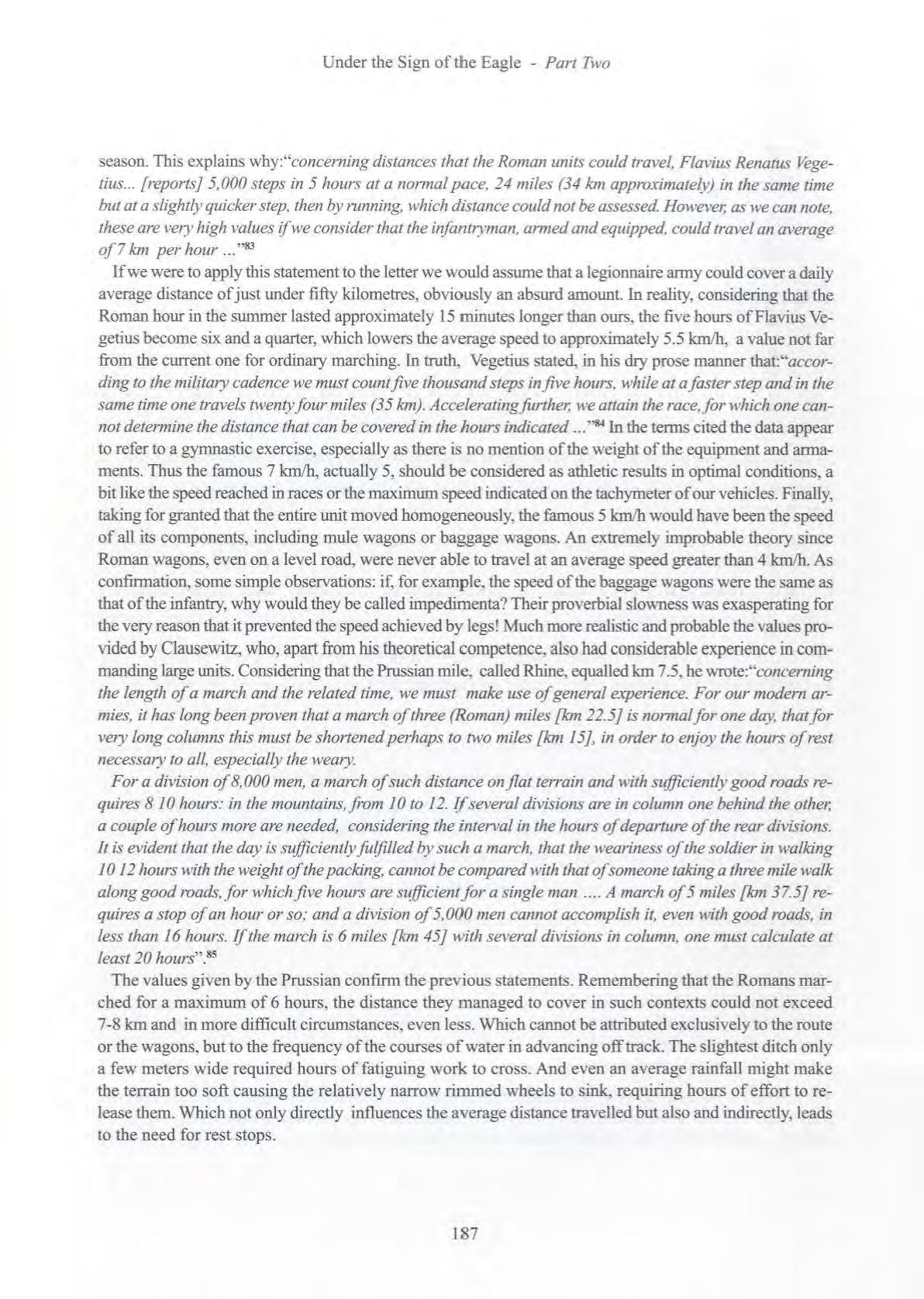
For a division of 8, 000 men, a march ofsuch distance on flat terrain and with sufficiently good roads requires 8 10 hours: in the mountains, from 10 to 12.1fseveral divisions are in column one behind the other, a couple ofhours more are needed, considering the interval in the hours ofdeparture of the rear divisions. It is evident that the day is sufficiently fulfilled by such a march, that the weariness ofthe soldier in walking 10 12 hours with the weight ofthe packing, cannot be compared with that ofsomeone taking a three mile walk along good roads,forwhichjive hours are sufficient fora single man A march of5 miles [km 37.5} requires a stop of an hour or so; and a division of 5,000 men cannot accomplish it, even with good roads, in less than 16 hours. If the march is 6 miles [km 45} with several divisions in column, one must calculate at least 20 hours". 85
The values given by the Prussian confirm the previous statements. Remembering that the Romans marched for a maximum of 6 hours, the distance they managed to cover in such contexts could not exceed 7-8 km and in more difficult circumstances, even less. Which cannot be attributed exclusively to the route or the wagons, but to the freq uency of the courses of water in advancing off track. The slightest ditch only a few meters wide required hours of fatiguing work to cross. And even an average rainfall might make the terrain too soft ca using the relat ively narrow rimmed wheels to sink, requiring hours of effort to release them. Which not only directly influences the average distance travelled but also and indirectly, leads to the need for rest stops.
Notes
1 - L. QUILl Cl, Roma primitiva e le origini del/a civilta laziale, Rome 1979, p .29.
2 -A. BERNARDI, M. A. LEVI, Le origini di Roma , in La Storia, Milan 2006, vol.ill, p. 658.
3 -F. RUSSO, F. RUSSO, Indagine sul/e Forche Caudine, immutabilita dei principi dell 'arte militare, Rome 2006, pp.145 and foil.
4 - T. MOMMSEN, Storia di Roma antica, bk. Il, Dalle origini a/la cacciata dei re di Roma, reprint Bologna 1979, vol.II, p. 546.
S-T. MOMMSEN, Storia di Roma , cit., vol. Il , p. 546.
6- G. TAGLIAMONTE, I Sanniti Caudini,lrpini, Pentri, Carnicini, Frentani, Milan 1997, p. 13-21.
7- Y. GARLAN, Guerra e societa nel mondo antico, Bologna 1985, p. 156.
8- XENOPHON, Anabasi, translation F.Ferrari, bk. ill, 2.18.
9- T. MOMMSEN, Storia di Roma ... , cit., vol. II, pp. 413 and foil.
10- T. MOMMSEN, Storia di Roma , cit., vol. II, p. 547.
11 - A. BERNARDI, M. A. LEVI, Le origini di Roma ... , cit., vol.III, p. 661.
12- F. RUSSO, Faicchio,fortificazioni sannite e romane, Piedimonte Matese 1999, pp. 51-87; also F. RUSSO , Trenta secoli difortificazioni in Campania, Piedimonte Matese 1999, pp. 89- 104.
13- F. RUSSO, Faicchio,fortificazioni , cit., pp. 108-116.

14- J . WACHER, Il mondo di Roma imperiale, Bari 1989, p. 87.
1 5-1. WACHER, fl mondo di Roma , cit., p. 88.
16- Y. GARLAN, Guerra e societa , cit., p. 142.
17- POLYBIUS OF MEGALOPOLIS, Storie, ed by G. B. CARDONA, Naples 1968, bk VI, 19. p. 171. The phrase has been translated as: "the number of(annual) campaigns they must undertake is ten for the cavalry and six for the infantry ". However, other translators are of the more believable opinion that it should be read as:"a cavalry soldier must serve for ten years, and an infantryman for sixteen "- from J. WACHER, 11 mondo di Roma , cit., p.89.
18- The term 'navy' understood as a service separate and distinct from the army, is misleading as at the time warships were used as a means of transportation and combat for the legions , exactly like the siege engines. However, given the importance of naval forces during the Imperial Era, the word appears if not
Under the Sign of the Eagle - Part Two justified, at least justifiable. Cf. F. RUSSO , F. RUSSO, 79 d. C. Rotta su Pompei. lndagine sulla scomparsa di un Ammiraglio, Naples 2006, pp. 126-212.
19- POLffiiO DI MEGALOPOLI, Storie ,cit., bkVI, 20-26, pp.l70-176.
20- C. BLAIR, Enciclopedia delle armi, Verona 1979, p. 359, under pilum.
21- Y. GARLAN, Guerra e societa , cit., p. 152.
22- F. RUSSO, lngegno e paura, Roma 2006, pp.97-146.
23 -C. G. CESARE, De bello gallico, bk V, 48.
24- W. REID, La scienza delle armi, Milan 1979, p. 16.
25- A. ANGELINI, L 'arte militare di Flavio Renato Vegezio, Roma 1984, bk II, 2, pp. 44-45.
26- J. WACHER, ll mondo di Roma , cit., pp. 113-120.
27- The promontori ofCalos, now corresponds to Cap Blanc near Bizerte, north ofTunis.
28 - The text of the treatise by Polybius, is taken from D. CARRO, C/assica. Storia de/la marina di Roma. Testimonianze dall 'antichita, sec. ed., supplement to the Maritime Review n° 12, Rome 2000, vol. I, p. 18.

29- D. CARRO, Classica ... , cit., vol. I, p. 22.
30- Y. GARLAN, Guerra e societa , eh., p. 201.
31- POLffiiO DI MEGALOPOLI, Storie ... , cit., bk I, 20, vol. I, p.l23.
32- DIODORO SICULO, XIV, 41, 3-42,2.
33- POLffiiO DI MEGALOPOLI, Storie , cit., bk I, 20, volo. I, p.l23.
34- POLffiiO DI MEGALOPOLI, Storie ... , cit., bk I, 20, vol. I, p.124.
35- F. RUSSO, F. RUSSO, 79 d. C. Rotta su Pompei , cit., pp. 134-142.
36- V. FOLEY, W. SOEDEL, Antic he navi da guerra a remi, in Le Scien:::e n° , pp. 95- 106. See also
E. CECCHINI, Tecnologia ed arte militare, Rome 1997, pp. 48- 50.
37- The quotation from Polybius is taken from D. CARRO, Classica , cit., vol. I, p. 48.
38- The quotation from Polybius is taken from D. CARRO, Classica ... , cit, vol. I, p. 48.
39 - E. GAB BA, Le origini dell 'esercito professionale in Roma: i proletari e la rifomza di Mario, in «Athenaeum», XXVII, 1949, p. 176-178.
40 -E . GAB BA, Le origini dell 'esercito ... , cit., pp. 201-202.
41- J. WACHER, I/ mondo di Roma ... , cit., p. 97.
42- A. BERNARDI, M. A. LEVI , Le origini di Roma , cit., vol. ill, p. 665.
43- J. WACHER, Jl mondo di Roma , cit., p. 97.
44- M. T. CICERONE, Tusc. II, XVI, 37.
45 - M. FEUGERE, Les armes des romains, de la Republique aI 'Antiquite tardive, Paris ed. 2002, pp. 72-73.
46 -F. RUSSO, Tormenta. Venti secoli di artiglieria meccanica, Rome 2002, pp. 176-177.
47- F. RUSSO, L'artiglieria delle legioni romane, Rome 2004, 121 - 169.
48 -The modioli of the relic found in Ampurias, Caminreal and Cremona have a insertion diameter between 0 mm 76 and 0 mm 80. The modioli of another catapult found in Morocco, nears the ruins of the Roman city of Sales are almost identical. See C. BOUBE- PICCOT, Elements de catapultes en bronze decouverts en Mauretanie Tingitane, in Bulletine d'archeologie marocaine, Tome XVII 1987-1988, p. 213. The one found near Lyon is also of the a similar diameter, cf. D. BAATZ, M. FEUGERE, Elements d 'une catapulte romaine trouvee aLyon, in Gallia, fouilles et monuments archeologiques en France metropolitaine, Paris 1981, pp. 201 and foil.
49- T. CELOTTI, Storia di Spagna, sec. ed. Milan 1940, pp. 50-51.
50 - For further study see E. SCHRAMM, Die antiken Geschutze der Saalburg. BemerX:ungen zu ihrer Rekonstruktion, Berlin 1918.
51 - See J. D. VICENTE, M. P. PUNTER, B. EZQUERRA, La catapulta tardo-republicana y otro equipamiento militar de 'La Caridad' (Caminrea/, Teruel), in Journal of roman military equipment studies, vol.8, 1997, pp. 167-199.
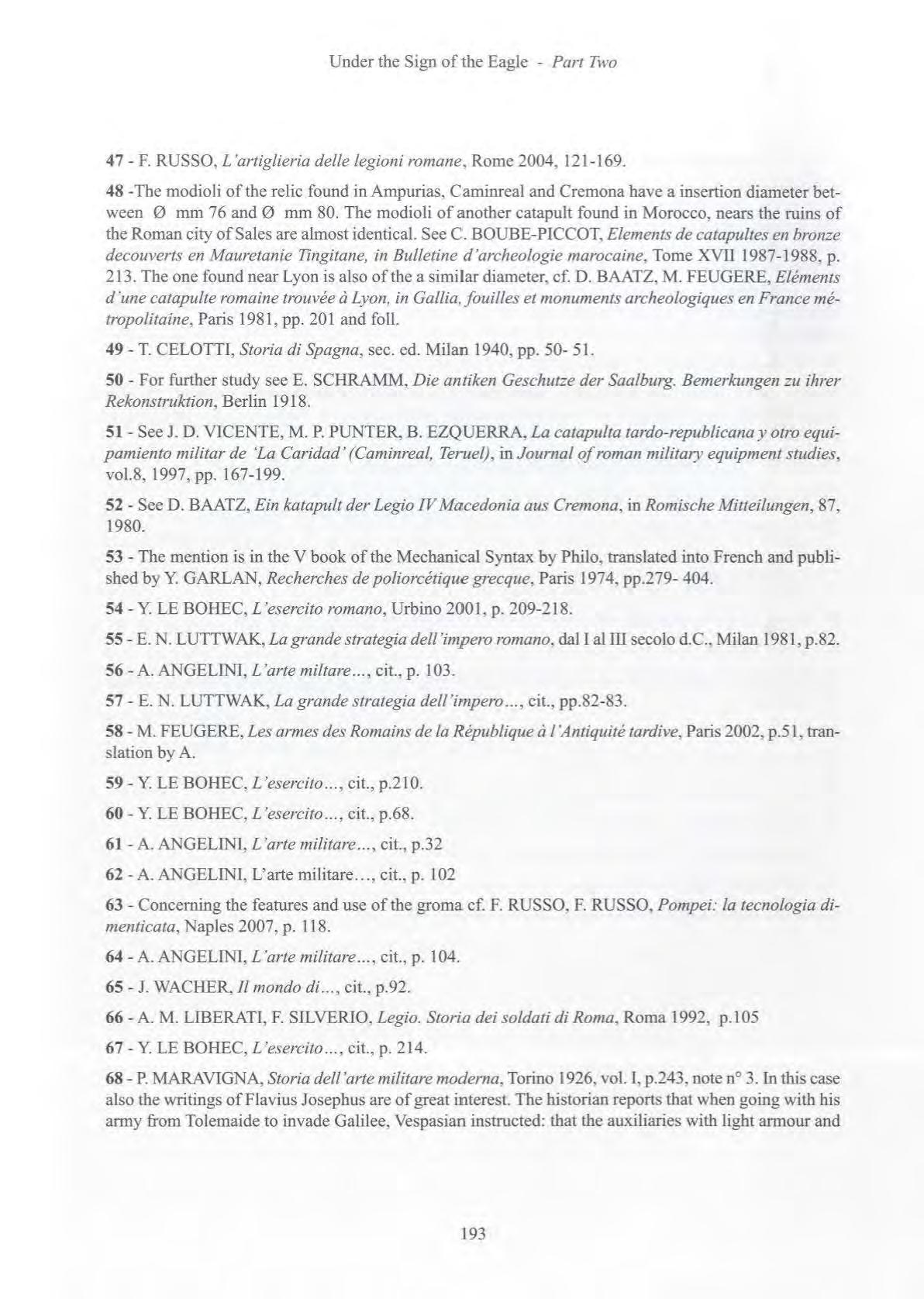
52 - See D. BAATZ, Ein katapult der Legio IV Macedonia aus Cremona, in Romische Mitteilungen, 87, 1980.
53 - The mention is in the V book of the Mechanical Syntax by Philo, translated into French and published by Y. GARLAN, Recherches de poliorcetique grecque, Paris 1974, pp.279- 404.
54- Y. LE BOHEC, L'esercito romano, Urbino 2001, p. 209-218.
55- E. N. LUTTWAK, Lagrandestrategia dell'impero romano, dal I al Ill secolo d.C., Milan 1981, p.82.
56- A. ANGELINI, L'arte miltare , cit., p. 103.
57- E. N. LUTTWAK, La grande strategia dell'impero ... , cit., pp.82-83.
58 -M. FEUGERE, Les armes des Romains de la Republique a I 'Antiquite tardive, Paris 2002, p.51, translation by A.
59- Y. LE BOHEC, L 'esercito , cit., p.210.
60- Y. LE BOHEC, L 'esercito , cit., p.68.
61 - A. ANGELINI, L 'arte militare , cit., p.32
62- A. ANGELINI, L'arte militare , cit., p. 102
63 - Concerning the features and use of the groma cf. F. RUSSO , F. RUSSO, Pompei: la tecnologia dimenticata, Naples 2007, p. 118.
64- A. ANGELINI, L'arte militare , cit., p. 104.
65- J. WACHER, I! mondo di ... , cit., p.92.
66- A. M. LffiERATI, F. SILVERIO, Legio. Storia dei soldati di Roma, Roma 1992, p.105
67- Y. LE BOHEC , L'esercito , cit., p. 214.
68- P. MARAVIGNA, Storia dell'arte militare modema, Torino 1926, vol. I, p.243 , note n° 3. In this case also the writings ofFlavius Josephus are of great interest. The historian reports that when going with his army from Tolemaide to invade Galilee, Vespasian instructed: that the auxiliaries with light armour and the archers should be in front to repel enemy attacks and explore the woods to prevent ambushes; they were accompanied by a contingent of Roman soldiers with heavy arms, some on foot and some on horseback. Behind them came ten men for every century, carrying their baggage and the tools to measure for the camp, then came the sappers to straighten the tortuous paths, level the ground and eliminate vegetation that obstructed passage to facilitate the march of the army "
69- A. LIBERATI, F. SILVERIO, Legio , cit., p. Ill
70 -The ftrst railway in Italy, the Naples-Portici, was built to provide transportation to the shipyards of Castellarnmare di Stabia, and from there to Capua. In both cases they were strictly military structures.
71- E. N. LUTTWAK, La grande strategia dell'impero romano ... , cit., p. 277, note n ° 6.
72 -The quotation is from Cenni elementari di Arte Militare, Rome 1874, p. 71
73 - Cenni ... , cit., p. 74.
74- G. B. CARDONA (edited by), Polibio , cit, vol. II, pp. 187-188.
75- A. ANGELINI, L 'arte militare , cit., p. 93.
76- G. ULLOA, Dell'arte del/a guerra, Torino 1851, vol. II, p. 175.
77- G. ULLOA, Dell'arte , cit., vol. I, p. 50.
78- G. PALMIERI, Riflessioni critiche sull 'arte de/la guerra, edited by M. Proto, reprint Mandria 1995, p. 545.
79- G. ULLOA, Dell'arte ... , cit., vol. I, p. 51.
80- G. ULLOA, Dell'arte ... , cit., p. 52.
81 -G. PALMIERI, Riflessioni critiche , cit, p. 543.
82- G. PALMIERI, Riflessioni critiche ... , cit., p. 546.
83- A. LIBERATI, F. SILVERIO, Legio ... , cit., p . 111.
84- A. ANGELINI, L 'arte militare ... , cit., p. 16.
85- K. VON CLAUSEWITZ, Della guerra, Trento 1982, p. 389.
